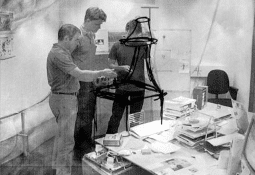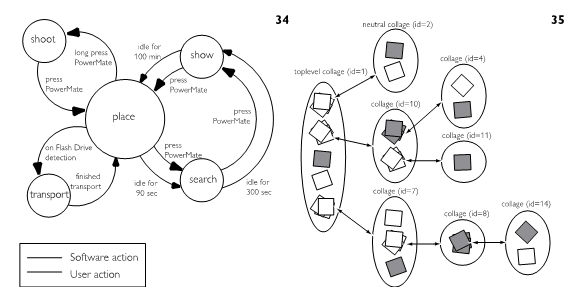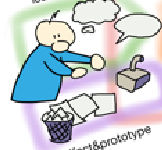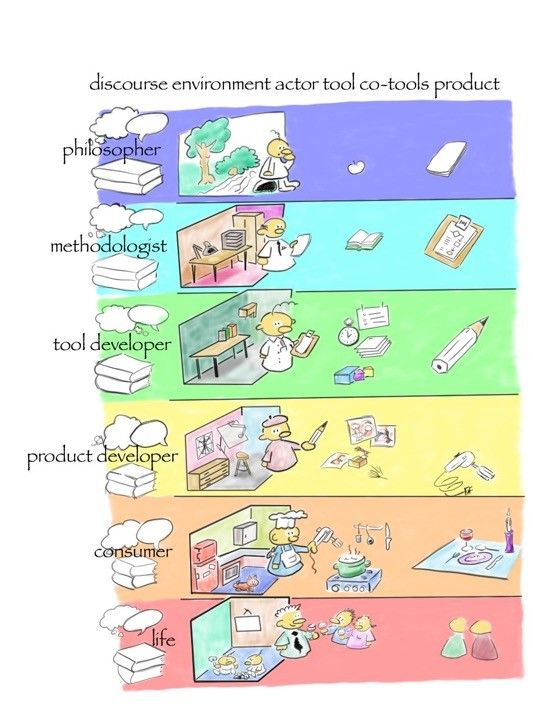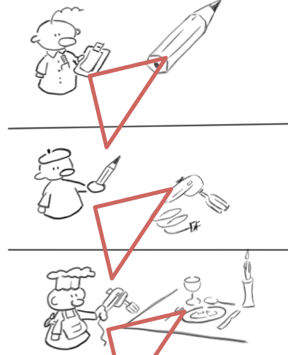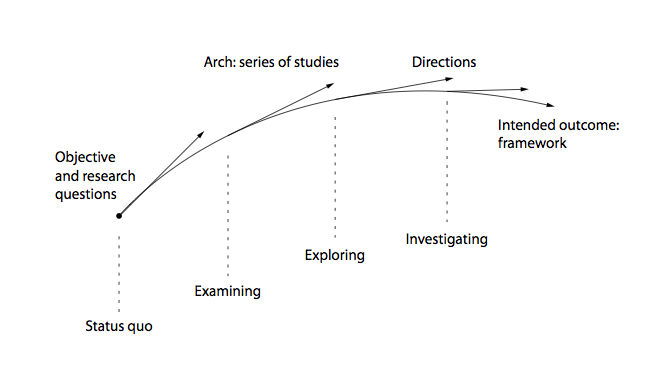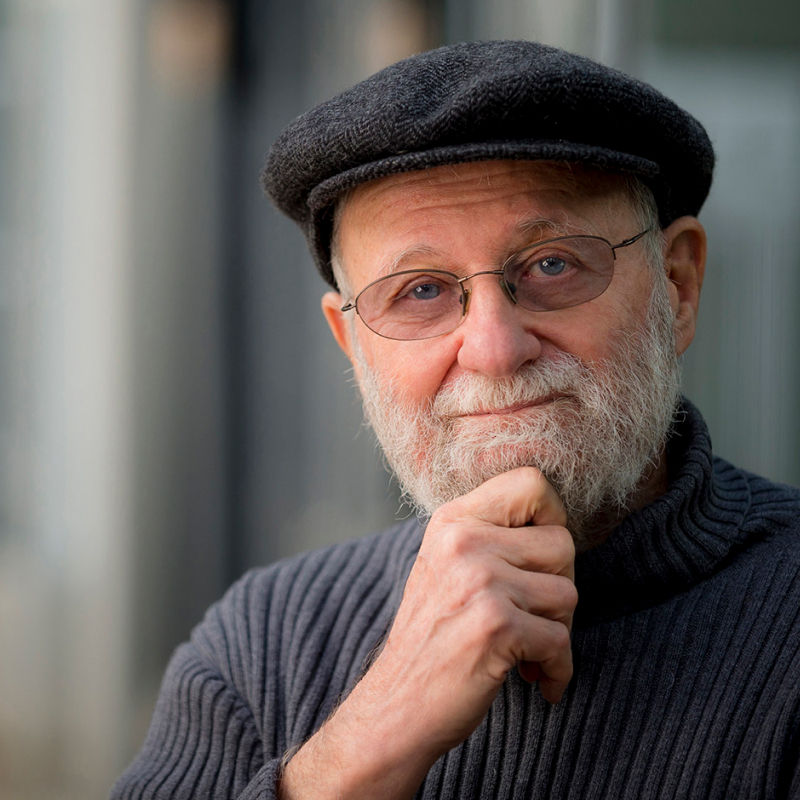For a long time, design and research have been regarded as separate endeavors – the former residing in industrial practice and craft, the latter in academic experiments and reflection. In the past decades, as areas such as interaction design and other forms of design were growing their academic basis, became more widespread as subjects taught at universities, and grew a research culture, two things happened. First, doing research became a recognized part of designing products (and later services). Second, design activities, along with designed artifacts, would become established as the chief elements in the process of generating and communicating knowledge. Ever since Frayling’s influential speech (1993, 2015), these two have become referred to as research for design and research through design (RtD), respectively.
As of the latter years of the 2010s, explicit theory about RtD is still in its formative stage. Given this, the involved communities are still struggling to find the right words, models, and practices. In this chapter, outlined in Table 1.1, we try to sketch the field and its themes, show what’s been published, and draw parallels to other research approaches, both within interaction design and in broader areas of design and engineering.
1 | Preface | ||
2 | Working definitions | Research, design, prototype, artifact, knowledge, practice | Positions the terms in the field and scans it quickly so you can return and find it again later |
History of the term | RtD and related | ||
3 | Examples | Wensveen, Keller, Gaver, Mattelmäki, Lundström, Rygh, Wright | Covers examples for the themes below |
4 | Themes | Artifact, knowledge, learning, sharing | Relates the main discussion themes and proposed theories |
5 | Conclusion | ||
6 | References | ||
7 | Appendix: Framings | Horvath, Mintzberg, Stokes, Harré | Brings in perspectives from outside the HCI field which put RtD in a broader perspective |
Table 1.1 – Guide to reading the chapter
41.1 Introduction: ‘Design’ & ‘Research’
Both operative terms ‘research’ and ‘design’ come with a variety of meanings, connotations, and expectations. And often these are left vague and undefined. The purpose of research is seen as the production of knowledge that others can use in other areas than the producer of the knowledge is working on. This knowledge is generalized and abstract. The purpose of design is usually understood to be the creation of a specific solution to be applied in the world: for example, a race car, a smart pill dispenser, an online banking service. The solution has to fit the here and now. Nevertheless, some differences are often noted (see Table 2.1):
Research | Design | |
Purpose | general knowledge | specific solution |
Result | abstracted | situated |
Orientation | long-term | short-term |
Outcome | theory | realization |
Table 2.1 – In general, the terms ‘research’ and ‘design’ carry different connotations.
Liz Sanders (2005) compared design research in academia and industry, and noted similar differences between the two approaches. We can see these differences below, in Table 2.2.
Information-Based Design Research | Inspiration-Based Design Research | |
1 | Tends to be conducted by people who are trained in research and/or the applied social sciences | Tends to be explored and applied by designers |
2 | Has borrowed heavily from the scientific model of research with its adherence to the tenets of good research: reliability, validity, and rigor | Is discovering its own tenets of good research such as relevance, generativity, and evocativeness |
3 | Is built upon the results of investigation, analysis and planning | Is built through experimentation, ambiguity, and surprise |
4 | Relies primarily on extrapolation from past events as a way to move into the future. | Draws primarily from the future and the unknown, using imagination as the basis for expression. |
Table 2.2 – Sanders (2005) lists differences in ‘traditional’ (e.g., usability testing and ethnography) and more ‘designerly’ (e.g., cultural probes and generative techniques) approaches to design research.
Despite such differences, design and research activities can be surprisingly similar – both aim to create something new, building on what was known before.
Both contain parts of the other. Analysis and evaluation are research activities in a design process (but are less visible than concept design sketches or final products). And research projects also involve the development (including design) of apparatus, stimuli, and creative new directions (but are less visible in the academic publishing culture than results, proof, and statement of theory).
Research through Design (RtD) continues to develop in between these tensions, together with the development of design education as a scientific discipline at arts academies as well as regular and engineering universities, and with Ph.D. students both employing their design skills as essential ingredients to their research and becoming outspoken about this. As such, this exciting realm continues to expand, ever pushing at the frontiers so that the wealth of possibilities can yield groundbreaking insights as more becomes known.
41.1.1 Defining Research and Design
The academic design culture is still developing in overlap with the diverse and quite different cultures of engineering, the arts, (social) sciences, cognition, business studies, humanities, research methodology, and philosophy. Many of the terms used in the discourse come from these disciplines and carry implicit meanings and connotations. This can lead to misunderstandings where a writer and a reader, or a speaker and a listener, have different backgrounds and understand the terms differently. While such a hazard tends to be inevitable when worlds ‘collide’ in this way, the effect is undeniable: Discussions can become very confusing when terms such as design, research, interaction, and experience are chained together in various combinations.
As a remedy to this, for this chapter we will use working definitions stated in simple terms, to avoid, or at least postpone, getting entangled in the jargon and background knowledge of the various academic fields connected with our topic.
Table 2.3 lists some terms that will play a prominent role in the further discussions.
Working Definition | Key Associated Terms | |
Doing Research | Work done with the intention to produce knowledge for use by others | Question, hypothesis, theory, investigation, interpretation, generalization, validation, discovery |
Doing Design | Work done with the intention to produce a feasible solution to improve a given situation | Idea and concept generation, synthesis, development, integration, discovery, prototyping, invention, implementation, realization |
Artifact | Object (often material) created during a design process | Sketch, blueprint, brief, specifications, vision, proposal, recommendation, business plan |
Prototype | Artifact used in research that can realize the (inter)action that is studied | Implementation, realization, test, exploration, solution, proof of concept, construction |
Knowledge | Understanding about the world that can be communicated to others | Theory, book, publication, expertise |
Design Practice | The ways in which design professionals conduct their work | Brief, contract, client, stakeholder, studio |
Experiment | Specific: a piece of controlled, hypothesis-testing research; General: an explorative confrontation with real-world situations | Specific: hypothesis, statistics, (in)dependent variables; General: trial, intervention, exploration |
Table 2.3 – Working definitions of key terms used in this chapter
None of these definitions is without objection. So, here are a few notes on these terms to clarify why we need to define them explicitly. For instance, the inclusion that research is done ‘for use by others’ is a demarcation stating that the discussion focuses on growing a shared body of knowledge rather than personal growth only, not a statement that the latter cannot be called ‘research’ in other contexts.
We added the verb ‘doing’ to both design (and research) to emphasize we are talking primarily about design activities, not about the many different meanings that the noun ‘design’ can have: product, styling, community of professionals, etc. (Sanders & Stappers 2014, p26).
In the definition of ‘doing design’, we use the term ‘solution’ (rather than ‘plan’ or ‘proposal’) to indicate that a realization—albeit of an experimental nature—is typically part of RtD. Some uses of the term ‘design’ stop at the making of a proposal in the form of a vision, illustration, or storyboard. In RtD, often the struggle with the elements of realization is considered an important part of the work. The improvement strived for in designing can concern problems (e.g., bad elements of an existing situation) or opportunities (e.g., possibilities of new technologies). Its result can likewise be varied: a (mass-produced) product, a piece of software, a service, or a system. See Figure 2.4.
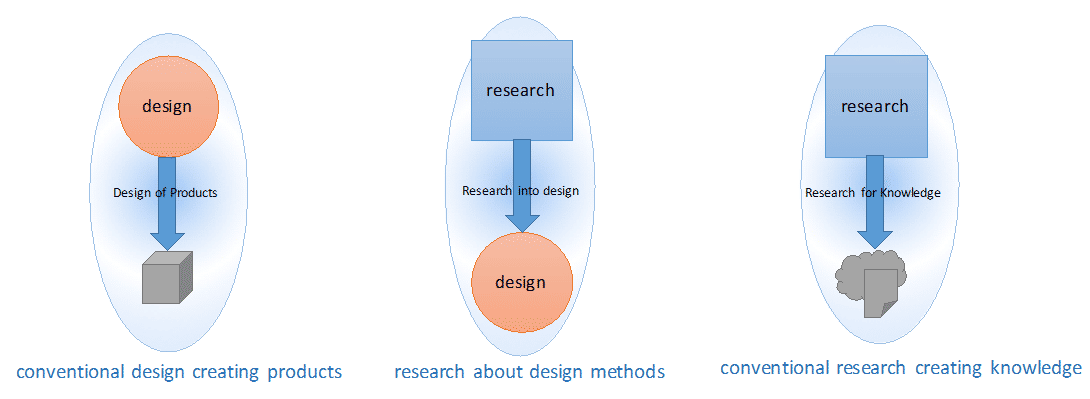
Figure 2.4 – The aimed-for results of research and design are often different. This chapter aims to describe academic theory about the contributions of design to knowledge, and in that respect is itself in the middle category, ‘research about design methods’.
The term ‘artifact’ originates in anthropology/archeology, and refers to a man-made thing, usually a material object. It will play an important role, because many researchers regard the things made by designers to be core to RtD. (Note: the term ‘artifact’ means something completely different in measurement methodology, namely an error in measurement such as a scratch on a photograph.)
The term ‘prototype’, along with the verb ‘prototyping’, has become popular in design research, and especially so in interaction design. Originally, the term indicated a precursor of a mass-produced product, which shares its material qualities, but will undergo testing and development during implementation. In design research, the term ‘prototype’ is also used for all kinds of product-like physical constructions. In interaction design, paper prototyping can be as simple as drawings on paper. Prototypes are a narrower category than artifacts. They are ‘like products’ in the sense that someone can interact with them and experience them, whereas sketches and blueprints are less direct representations about—rather than realizations of—intended situations and interactions. In the RtD literature, some authors use the term ‘artifact’ (or, in British/Commonwealth English, ‘artefact’) with this meaning that we reserve for ‘prototype’, but without making the difference explicit. In this chapter, we use the distinctions above – that every prototype involves an artifact or artifacts, but that not every artifact is a ‘prototype’ (see Figure 2.5).
|
|
|
Sketch (over photo) | Diagrams | Prototype |
Figure 2.5 – Examples of different types of ‘artifacts’ in design, only one of which we will refer to as a ‘prototype’ (from Keller, 2005, pages 89, 109, 107).
For the term ‘knowledge’, we again hope that it doesn’t cause any confusion. An important aspect of knowledge is that it connects to something in the world and that it has a use in guiding someone’s future actions in the world. Knowledge can be explicit (e.g., described with words and pictures in a book) or tacit (e.g., when a professional craftsman builds on his earlier experiences). In the context of research (through design or otherwise), knowledge is sought so it can be shared with others. Explicit knowledge can be shared in straightforward ways; how, and to what degree, that can be done with tacit or implicit knowledge is part of the discussion (see section 4.1).
Finally, let’s look at two words which carry very different meanings: (design) practice and experiment. We will not use the term ‘practice’ extensively, but it pops up in two quite different meanings in the literature. One meaning is ‘a designerly way to deal with things’, as in finding a possible solution through sketches and quick prototypes instead of theoretical reasoning, mostly used to refer to the way work is done in art & design studios. The other meaning is ‘the work situation of design professionals’, in which they typically work for a client, to a brief which may include the point that the clients’ offerings are part of the designed solutions, with commercial constraints of time, means, and budget. The former meaning is probably intended where RtD is defined as “design practice is brought to bear on situations chosen for their topical and theoretical potential […]” (Gaver 2012, p937), the latter where Zimmerman, Forlizzi, and Evenson (2007) propose a model “to benefit the HCI research and practice communities” (p493).
Similarly, the term ‘experiment’ is narrowly understood (in ‘the scientific method’) as a piece of controlled research, in which variables are isolated and controlled, and a hypothesis is validated or rejected. But the term has another use – in a much broader sense of ‘trying something out to see if it works’ as either part of an inquiry or program (Redström 2011) or as part of an action-oriented intervention (Halse et al. 2010) (see section 4.3).
41.1.2 Relations between design and research
Research and design are closely related, but different. Both are intentional activities with the goal of creating something new. Yet they differ in the way they are (typically) conducted, and the values by which their outcomes are (typically) judged. Since the second half of this century’s first decade, many possible juxtapositions have received attention – one as part of the other, both as the same or completely different, or complications arising from applying one onto the other (or onto itself).
41.1.3 Research for Design: Doing research as a part of doing design
The activities of observation, measurement, interview, literature review, analysis, and validation, which are part of many design approaches, clearly come under ‘research’. Modern design curricula pay explicit attention to research skills, ranging from the ability to gather and interpret scientific knowledge, to generating new knowledge where that is needed, as illustrated in Figure 2.6. Because scientific theories are defined at a generalized and abstracted level—e.g., “people can deal well with up to 7±2 categories”—there is a gap that must be bridged when applying this in a design brief – e.g., “designing an information service for elderly Dutch people to organize their weekly shopping”. The gap has to do with both the level of abstraction (e.g., “What ‘categories’ play a role in the design situation?”) as well as sufficiency (e.g., “Can we find appropriate ways of ‘identifying and dealing with’ selected categories?” and “How do these fit in with the dozens of other considerations that are needed in this situation?”). Many design curricula these days pay explicit attention to gathering and applying relevant scientific and technological information, and to conducting studies to learn specific information about the situation for which the design is made, sometimes referred to as research for design. In particular, technical feasibility and usability studies of prototypes—and more recently, early phase participative studies into user requirements (‘user research’ or ‘design research’)—have become accepted ingredients of user/human-centered design methodology.
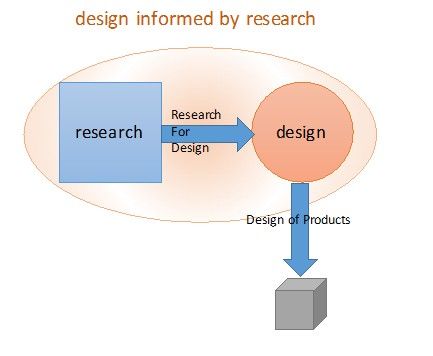
Figure 2.6 – Design informed by research: Relevant scientific and technological information is gathered and applied, and studies are conducted so as to learn specific information about the situation for which the design is made.
41.1.4 Research through Design: Doing design as a part of doing research
When we talk about RtD, we indicate design activities that play a formative role in the generation of knowledge, typically actions that we’d recognize as design activities from one of the design professions, that depend on the professional skills of designers such as gaining actionable understanding of a complex situation, framing and reframing it, and iteratively developing prototypes that address it. This designerly contribution may be as simple as making stimulus material for use in somebody else’s research. However, more typically, it consists of the development of a prototype (or artifact) that could be mistaken for a ‘product’, and that plays a central role in the knowledge-generating process (See Figure 2.7). For instance, it shows a hitherto nonexistent combination of factors as a provocation for discussion, or it creates the possibility for people and products to engage in interactions that were not possible before, and these can come into existence—indeed, become observable—through the design. Moreover, in the generative process of ideation, concept development, and making that brought this prototype into existence, the designer(s) will have struggled with opportunities and constraints, with implications of theoretical goals/constructs, and the confrontation between these and the empirical realities in the world. In other words, any designer involved with the prototype will have had to navigate around the real-world obstacles that got in the way of building the best bridge between the product and its usership. This thinking process in itself brings about insights, some of which can be made explicit and shared with others. It is how facts emerge from the shadows and help future endeavors.
“The pessimist complains about the wind; the optimist expects it to change; the realist adjusts the sails.”
—William Arthur Ward, American writer of inspirational maxims
Most academic publications about RtD focus on the prototype, and illustrate some of the design steps that led to it with a message like “It really took design skills to make this prototype, and we took a lot into account.”, just as illustrations of the design activities that are common in industrial design practice. Yet these activities themselves may be where insight was generated.
“The designing act of creating prototypes is in itself a potential generator of knowledge (if only its insights do not disappear into the prototype, but are fed back into the disciplinary and cross-disciplinary platforms that can fit these insights into the growth of theory).”
—(Stappers 2007)
The act of designing, of making, requires the designer to face several confrontations: between competing or conflicting background knowledge, between theory and technology, and between dream and reality. Making provokes a particular cognitive activity, one which can be used to make people aware of tacit values and latent needs (Stappers 2013).
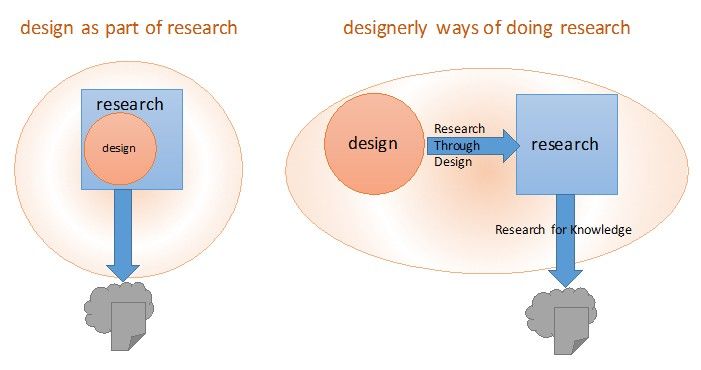
Figure 2.7 – Designerly ways of contributing to research (left) and doing research (right). In the former, design activities create tools or stimuli ‘on spec’ from the research; in the latter, the design actions play a formative role in the generation of knowledge.
41.1.5 Research is Design: Doing design is doing research
Some authors (e.g., E. Zimmerman 2003) indicate that design is a form of research, or that design and research are essentially the same, in that both activities can result in new knowledge. Figure 2.8 expresses this in the style of the previous diagrams as a single ‘blob’ and no arrows. This expresses the joy of designers that in every design project they (can) learn something: about the users’ lives, about a piece of technology, about a new mechanism or form, about how to create an effective prototype, or about how to evaluate it under challenging circumstances of limited budget, time, and means. But equating the two robs us of an instrument to talk about possible differences, and there are differences. And not every design process yields knowledge that is (made) available to others; in fact, most design products end with a ‘design’… and that’s it. Many don’t make it to a product. History is littered with such gems that never made it into the ‘real world’, even if their real-world potential might have been sound enough to sell well. And not every piece of research requires the creation of a new solution – a lot of research is content at describing the status quo. Friedman (2008) complains that many authors who approach research by design “adopt a misunderstood term for its sound-bite quality, linking it to an ill-defined series of notions that equate tacit knowledge with design knowledge, proposing tacit knowledge and design practice as a new form of theorizing” (p157). Like others, Friedman says the equation of the two is not useful.
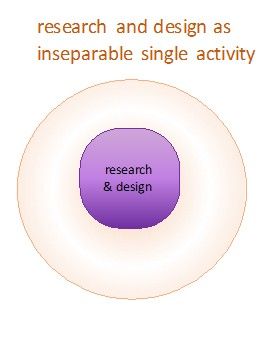
Figure 2.8 – Research and design activities are seen as the same by some authors.
41.1.6 doing research, and vice versa
The reverse view, that design and research are totally different or complementary activities or even that they are mutually exclusive, is heard less often. In schools where academics mostly do research and design practitioners solely handle the teaching, one sometimes sees the distinction between researcher and designer as a separation of roles and of values, usually with the statement that what applies to one is irrelevant for the other. Again, this distinction is not a helpful one in the context of this chapter; however, it is handy to know in a general sense.
41.1.7 Other relations
There are several other relations between research and design. Here, we’ll finish with a few, not because we want to puzzle our readers with word games, but because we will need them in a later discussion, namely in section 5. One can study how design is done by entering the realm of research into design (Frayling 1993); sometimes, it is referred to as design methodology research.[1]
Similarly, the terms can be used self-referentially, as researching research, in the evaluation of research methods as in Science Studies, and designing design, in cases where designers develop new methods and tools to support design activities – e.g., cultural probes. Quite a large part of the wealth of conference and journal papers in design is devoted to describing the process that was carried out, and presenting and reflecting on experiences with these tools and methods. Often, this is what forms the spearhead of the main academic contribution of the paper.
Finally, there is a sense in which any research project is in itself designed. The term ‘experimental design’ or ‘design of the study’ is used in various disciplines to refer to the planning and setup of a study – e.g., which conditions to use, or how to operationalize theoretical concepts into measurement actions. Although these actions are very real (and also apply to the type of research projects we discuss), this general understanding is not what we mean by RtD. Rather, we take it to be the production of knowledge by means of design activities.
41.1.8 er?
Should these activities be performed by a specially trained professional, someone with an official degree such as a ‘designer’? Some authors see RtD as the ways in which design practitioners can contribute to research, or the way design practice brings about knowledge in general. Our focus in this chapter lies on the design(erly) activities used in the production of knowledge – not on the qualifications of those who may be most suited for that by training or experience.
That being said, we have chosen the examples mainly from work by people with design training, because this is where the RtD discussion is most alive. But already there, there is a great variety in what the design profession entails, what defines which activities he or she is expert at, and in what way and about which aspects the knowledge is produced and shared.
Many of the application areas of design and research require collaboration between individuals from different disciplines, each with his or her own skills, expertise, and attitude. A trained designer can have several roles in such a team, including communication, facilitation, process management, framing and concept formation, explorative prototyping, evaluation, and critique – and so can other stakeholders in the process (Basballe & Halskov 2012).
41.1.9 Conclusion
This varied set of relations yields plenty of opportunity to be confused about what happened in a research project that used design methods. Was the knowledge that was generated about the prototype (i.e., a design result)? Was it about the way participants interacted with it (i.e., a contextual research result)? Was there something special about the way the design or research was conducted? Was the study dependent on (professional) design skills? Or was it (a mix of) all of these? We’ll return to these questions throughout the chapter.
41.1.10 History of the term ‘RtD’
Although most of the academic literature using the term ‘Research through Design’ is within the HCI community, the term originated in design, with no particular reference to interaction design. In fact, it also included other areas such as materials. The phrase ‘Research through Art and Design’ was coined by Frayling (1993, later positioned in its historical context in 2015) in a speech to the RCA, where he indicated three ways in which doing research would be of interest to the design community: research into art and design (including historical and perceptual research), research through art and design (mentioning materials, product development, and action research), and research for art and design (illustrating it with Picasso’s gathering of reference materials, “where the thinking is, so to speak, embodied in the artefact,” p5). Frayling’s brief descriptions align well with the definitions given in section 2.2 above. In later discussions, the phrase ‘art and design’ was shortened to just ‘design’. Some authors would take the shorter term for convenience, or because they felt less at ease with art in their academic community; others were to broaden the argument to the diversity of cultures within design, or even because they didn’t see the difference between art and design.
The term ‘Research through Design’ has mainly seen use in four ‘pockets of energy’ with different background cultures and geographic locations: the art and design community in the UK and Scandinavia, the technical universities and design academies in the Netherlands, and the human-computer interaction community in the US. Figure 2.1 gives an overview of the key sources used in this chapter. But the relevant literature is broader, as not everyone addressing the issues we identified and discuss in section 4 uses the same terminology.
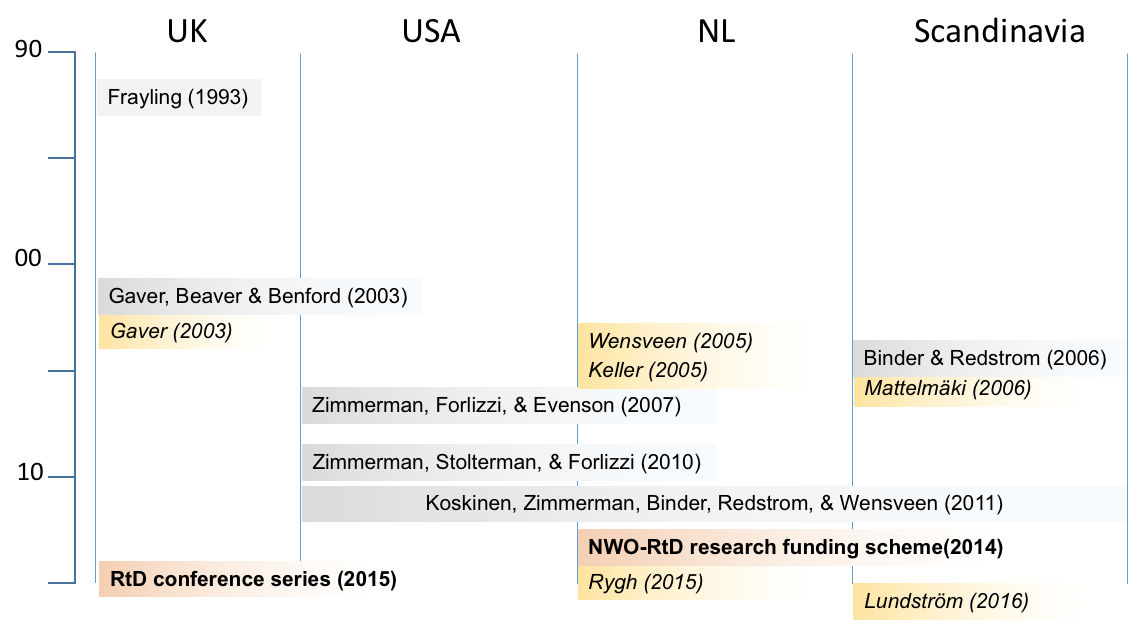
Figure 2.1 – A map of RtD projects and articles, spread over time and country of origin of the authors. Articles shown here are cited 10 times or more by articles in the references list of this chapter. In italics, we see the example projects of section 3; in boldface, the conferences and funding schemes.
41.1.11 In HCI and IxD
The Human-Computer Interaction (HCI) and Interaction Design (IxD) communities have been most prolific in developing explicit theory about RtD, possibly because the emergence of these fields occurred in a peer-reviewed academic culture embedded in and close to computer science in research universities. Both HCI and IxD are young fields. Closely tied to practical application, they have to deal with abstract problems raised by the difficulties of giving form to the new possibilities and complexities offered by information technology.
Possibly the first mention of the relation of Research and Design in this manner is in the introduction of Laurel’s (2003) book Design Research, and the subject is addressed in E. Zimmerman’s chapter on design research by play. This succinctly describes the intertwining of learning and solving that occurs in every design project, and emphasizes the point that questions emerge from doing design.
Needs and Pleasures
“Design is a way to ask questions. Design Research, when it occurs through the practice of design itself, is a way to ask larger questions beyond the limited scope of a particular design problem. When Design Research is integrated into the design process, new and unexpected questions emerge directly from the act of design.
(…)
Iterative design is a process-based design methodology, but it is also a form of Design Research. In each of these three case studies, questions emerged out of the process of design – questions that were not part of the initial problem but that were nevertheless answered through iterative design and play.”
—(Zimmerman, 2003, p. 184)
Discussion in HCI took off with J. Zimmerman and Forlizzi’s papers. Zimmerman, Forlizzi, and Evenson (2007, p. 494) demarcate the subject as follows: “we intend the term design research (sic) to mean an intention to produce knowledge and not the work to more immediately inform the development of a commercial product”. In Zimmerman, Stolterman, and Forlizzi (2010), RtD is defined as “a research approach that employs methods and processes from design practice [sic] as a legitimate method of inquiry”. They interview researchers and find that many of them “view RtD as a designerly inquiry focused on making of an artifact with the intended goal of social change” (which would be called ‘social design’ or ‘critical design’ elsewhere) and advocate a more rigorous formulation of methods to make the legitimacy more acceptable to established scientific traditions. Similarly, Keyson et al. (2009) propose to include formal measurement as part of RtD so as to validate and strengthen the robustness and generalization of findings.
Gaver argues against such formalization as running the risk of stifling essential qualities of designing and positioning design practice against “some dominant models of doing research”; he warns against “hopes for general applicability of findings”. Instead, the claims for general knowledge and the hopes for sharing insights should be more informed about the patterns in which expert knowledge is shared in craft communities, through examples and reflection. Gaver (2012) defines RtD as “design practice” that “is brought to bear on situations chosen for their topical and theoretical potential” with the resulting designs seen as “embodying designers’ judgments about valid ways to address the possibilities and problems implicit in such situations” and reflection on these results allowing “a range of topical, procedural, pragmatic, and conceptual insights to be articulated.” Bowers (2012) and Gaver and Bowers (2012) indicate that much of the knowledge about/in design cannot be readily abstracted through the verbal channels of academic journals, but instead is conveyed by annotated portfolios: collections of design models, sketches, photos, etc., combined with explanations that frame and bring forward the salient aspects carried in these artifacts.
Koskinen et al. (2011) summarize these positions in the coursebook Design Research through Practice. In addition, they present a number of projects, and how they fit into design activities, by distinguishing three different types of designerly ways of doing research identified by the location of dissemination: field, showroom, and lab.
41.1.12 In design
In the design community, the term grew in popularity only more recently, again as the field was seeking to strengthen its academic grounding and to develop a research culture. Horváth (2007) reviewed a variety of design research projects and separated them into three approaches, depending on the relation between design and research: 1) researchers using the methods of established disciplines and applying them to design practice, 2) designers in industrial practice reflecting on their experiences in industrial projects, and 3) ‘design-inclusive research’, in which designerly actions, notably the creation of research prototypes, have played an important role (see also section 7.1).
Several authors have begun to collect and look at examples of research projects in which the researcher was a designer who placed, in Brandt and Binder’s words, “designerly experiments at the core of the research” (Brandt & Binder 2007). Their study, for example, compares three Ph.D. research projects by designers, each of which is differently informed by the use of design experiments as a means to explore a possible program (intended as a set of questions or inquiry): Kristina Niedderer (Falmouth College of Arts, UK 2004), Ianus Keller (TU Delft, Netherlands 2005), and Tuuli Mattelmäki (University of Arts and Design Helsinki, Finland 2006).
In the UK, a biannual conference started in 2013, which focuses on practice-based design research, i.e., the knowledge that comes out of design projects. The conference welcomes submissions from all areas of design and comprises a curated exhibition of design research artifacts accompanied by round-table discussions in so-called ‘Rooms of Interest’. (RTD-conference, http://researchthroughdesign.org/)
The term ‘RtD’ has also entered research policy. In 2014, the Netherlands Organisation for Scientific Research launched a research program called ‘Research through Design’, specifically for strengthening research in the creative industry and the various design disciplines, ranging from Industrial Design to Gaming, Architecture, and Fashion (NWO-call). Most of the awarded projects in the Dutch program were collaborations between universities and academies, often involving professional design agencies and industrial partners.
Design departments in various universities in Europe are including explicit reflection on methods of design and research high on the agenda. However, there is considerable variety in the work approaches, and in the academic settings where the discussion takes place. For instance, in the UK and Scandinavian countries, RtD grew in the art schools, with an emphasis on crafts, studios, and exhibitions. In the Netherlands, the Universities of Technology at Delft and Eindhoven have been prominent, which shows an explicit linkage to industry, technology, and the social sciences. In the USA, the work centers mostly around HCI-based researchers (Zimmerman and Forlizzi at CMU, and Stolterman and Bardzell at Indiana University).
Less constrained by the performance assessments that determine many aspects of research in the UK and Commonwealth countries such as Australia and Canada, and because of often fully salaried doctoral positions (e.g., in Sweden) and a close connection to the creative industries (e.g., in the Netherlands), Northern European countries have developed a great deal of criticality and experimentation with questions, forms, and formats of knowledge production. As a result, rather than place emphasis on strong distinctions, the Scandinavian countries have developed a spectrum of approaches that might be broadly characterized as ‘research through design’, ranging from practice-based (Mäkelä 2007) to ‘constructivist’ (Koskinen et al. 2011) to ‘programmatic’ approaches to interdisciplinary research (Brandt & Binder 2007).
41.1.13 Beyond the design community
In section 2.2, RtD was operationalized as creating knowledge through a process in which design artifacts, notably prototypes, are made, tried out, and reflected upon. Although the RtD literature sees this as the particular niche where design skills, professionals, and communities earn their position in research, such approaches are also found outside ‘design’.
One approach in social sciences that is often mentioned as being related to the way RtD is conducted is Action Research. Kurt Lewin, the father of Action Research, emphasized that understanding something (research) and improving something (design) go very well together. The desire to make improvements can motivate and guide the learner, a statement close to the heart of designers (and resonating with E. Zimmerman’s observations about learning from design projects earlier in this section):
“If you want truly to understand something, try to change it.”
—(Kurt Lewin cited in Charles W. Tolman (1996) “Problems of Theoretical Psychology – ISTP” 1995. p. 31)
A rapidly growing field where RtD is conducted is also Design Anthropology (Smith et al. 2016). Design Anthropology focuses on working out the tension between the descriptive nature of anthropological research and the future-making attitude of doing design. Examining what design anthropology is and what it is becoming, scholars and practitioners in this field engage in and promote RtD processes and methods. Much of the argumentation for RtD as a different way of doing research involved comparison to the ruling positivist paradigm of experimental research methodology that was especially strong in HCI because of its roots in psychological research in the 1960s. Various authors justify RtD as standing apart from those reductionist, rational paradigms (Stolterman 2008), warn against reducing RtD to its methods (Gaver 2012), or advocate a strengthening of those ties (Keyson 2009, Zimmerman et al. 2010). But the wider field of scientific research has been much larger. In his ‘20 great experiments’, Rom Harré sketches a great variety of methods behind breakthroughs in the history of science: from Aristotle’s observation of the growth of the egg, to the null results of Michelson and Morley which formed the major support for the theory of relativity (see section 5.4). Variety in methods outside of design research is so large that the methods inside it may well have more connection points than we might expect.
Engineering in particular has a history in which the artifacts, as well as a design goal, have led the way. Bridges, manned flight, agriculture, medicine, and the military provide many examples and framings for comparison. In the next section, we will include one such example—namely, the Wright brothers’ development of the airplane, as an RtD case.
Another parallel can be found in industrial practice in the automotive sector, where the big manufacturers have their designers develop concept cars, not in order to put these on the market, but as a way to explore and prove, and communicate possible (and desired) new directions for their company. But although concept cars have a history of several decades and substantial investment, little academic work is available about how they can be seen as research projects (Mejia 2016). Such visionary projects and practices have been picked up also in HCI. Zimmerman, Forlizzi, and Evenson (2007) discuss Philips’ “vision of the future” as one example of RtD. In each of these, designerly action is made not for the purpose of an immediate commercial product, but for a more general understanding that leads to application elsewhere.
41.1.14 Labels and names
The term ‘RtD’ has gained popularity as a label to indicate the specific, unique contribution that doing design can bring to research efforts, but its issues are not always brought forward under that name. As is typical for design, there is a proliferation of ‘brands’ under which techniques and theories are marketed. Often, authors choose a different name because they don’t think the term ‘Research through Design’ entirely coincides with the type of research-design combinations they are addressing.
The field does not share a single jargon. Table 2.9 lists some of the labels given to such ways of doing research with a designerly component. Note, however, that few of them are described precisely enough to give a sharp demarcation, or to tell others how to do it successfully. Some of the authors we have not mentioned so far we will discuss in section 4.
Label | Authors include (but are not limited to) |
Experimental Design Research | Brandt & Binder (2007) |
Experimental Research through Design | Keyson & Bruns-Alonso (2009) |
Design Research through Practice | Koskinen et al. (2011) |
Constructive Design Research | Wensveen & Matthews (2014) |
Concept-Driven Design Research | Stolterman & Wiberg (2010) Höök & Lowgren (2012) |
Design-Inclusive Research | Horváth (2007) |
Inquiry-driven RtD | Odom & Wakkary (2015) |
Interaction Design Research | Zimmerman, Forlizzi, Stolterman (2007) |
Iterative Design | Zimmerman, E. (2003) |
Programmatic Design Research | Brandt, Redström, Eriksen, Binder (2011) Bang & Eriksen (2014) |
Research-Oriented Design | Falmann (2007) |
Table 2.9 – Some examples of different jargon terms used to refer to designerly ways of doing research
41.1.15 Conclusion
Research through Design is a term that is used primarily in academic work in the design communities, especially in interaction design and HCI, but it shares more than is usually discussed with other arts and engineering disciplines, and with design practice. In many places, we see that designerly actions not only contribute to achieving a local improvement in a single product or situation but also serve to discover, exemplify, clarify, and promote more general principles, which can be used elsewhere.
The views expressed in the literature do not easily fit into a single mold. The authors come from and refer to different backgrounds, have different aims, discuss different aspects, and build on different values. Some try to set RtD apart from other types of research (e.g., established methods in the sciences and social sciences). Others try to bring it closer to these methods, or to justify its existence as something else. The common core is that they advocate the contribution of designerly activities and qualities to the knowledge outcome, especially those activities that introduce prototypes into the world, and reflect, measure, discuss, and analyze the effect, sometimes the coming-into-being, of these artifacts.
As section 2.4 showed, the literature often introduces new labels, especially nouns to indicate a particular type of research, instead of discussing aspects of a shared way of doing research. Especially where authors then don’t refer to specific instances of ‘research’ or ‘design’, it becomes difficult for the readers to distinguish if they are presenting views of the same way of going about RtD, or totally different ways of going about it, which may occur side by side. As always with discussing abstractions, having a shared set of concrete things as examples and cases and possible instances certainly helps. This is exactly what we try to put forward in the next section.
41.2 Seven Examples of RtD Projects
As mentioned before, discussions about design and research can easily go afloat in abstractions. In this section, we briefly introduce some projects that exemplify the themes we will discuss in section 4. In making the selection, we first took a few that have already been discussed in the academic literature in the context of RtD (among others, in Brandt & Binder 2007, Zimmerman et al. 2010, Koskinen et al. 2011). Some were added so as to give empirical examples to ground the discussion of the themes in section 4, and to include descriptions from related work outside the HCI circle.
The seven examples presented in this chapter show the variety in methods of exploring, describing and evaluating, to reflect the state of the field. In each of them, the researcher-designer(s) had a knowledge goal which is explained, and results have been documented and shared with target audiences. But the specifics of the question and the method of dissemination were different. In each example, a series of prototypes and other artifacts were produced as steps in finding out knowledge about the research problem. However, the role of these artifacts varied, and so did the way in which the designer produced them and the way in which each artifact was placed in relation to earlier knowledge.
The following sections describe each of the example projects. In the concluding section (3.8), we bring them together on four main aspects:
What did they learn?
How was this knowledge shared with others, and who were they?
What did they do (method and process)?
What was made (the role of prototypes)?
Then, in sections 4.1–4.4, we discuss how these four aspects have been discussed in the literature.
The list is not a complete overview of all RtD projects; nor does it include all works that were much cited. Rather, these examples were chosen because ample documentation is available (online), so readers can themselves find out more details about the studies. For each example, references are given to sources where the work is described as RtD, and positioned, or framed by others than the researcher him/herself. Often, the first reference is the Ph.D. thesis, which usually contains further references to articles that were based on the project. In this section, we only include the latter if it explicitly discusses the method of research.
Where we could, we labeled the example with the name of ‘what was made’. One reason is to help the reader keep seven examples in mind. A second reason is that the role of prototypes and other design artifacts will be an important theme in section 4.2. For each example, we also remark on the other themes of section 4: knowledge that is generated, how that knowledge was learned, and the intended audience for sharing the knowledge.
41.2.1 Wensveen’s Alarm Clock
Stephan Wensveen’s Ph.D. project at Delft University of Technology started from a theoretical question: is it possible to design the emotional quality of interactions? To study these interactions, Wensveen designed and produced an alarm clock with an interface of 12 sliders that a user could move with two hands, in order to set the desired alarm ‘mood’.
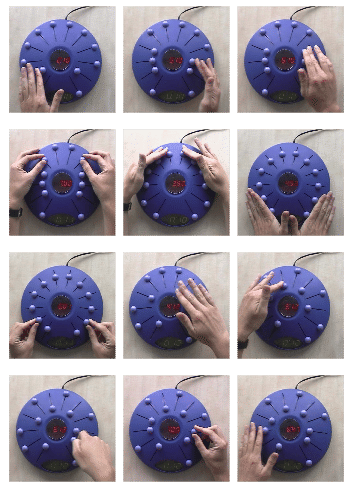
Figure 3.1 – Different ways of setting the alarm clock (courtesy of Stephan Wensveen). Consider the range of possibilities with those 12 sliders—and all the ‘finger choreography’ involved.
The prototype registered the motion-over-time patterns of the sliders to capture the users’ gestures. In the main experiment, the patterns of movements were registered for participants in different emotional moods. So as to put them in these moods, they were shown a selected movie scene. Then they had to set the clock in a way to match the scene. Patterns were then observed and recorded.
Measurements and ‘experimental design’ allowed the researcher to fit and publish the findings within an experimental research tradition. Prototype and experiment were addressed and discussed in several papers (Djajadiningrat et al. 2004, Wensveen et al. 2002, Zimmerman 2010, Wensveen & Matthews 2015), but much of the detail is only found in the Ph.D. thesis (Wensveen 2005). Notably, the thesis is lavishly illustrated with examples of relevant existing products (33 figures), prototypes by the researcher (19) and others (9), research tools (21), result data (28), and diagrams (14). These visuals form an important part of the argumentation in the thesis.
The knowledge generated in this process concerns a theoretical contribution to tangible interaction and, specifically, principles for designing for emotion in tangible interaction.
Several prototypes of an alarm clock that users can interact with physically in order to set the desired alarm ‘mood’ were made.
Knowledge was generated by ‘experimental design’ (here, design in the research methodological sense of independent and dependent variables). Results were shared via Ph.D. dissertation and academic publications. Visual documentation was also to play an important role.
Published in Wensveen 2005, described in Zimmerman et al. 2010, Koskinen et al. 2011.
41.2.2 Keller’s Cabinet
Ianus Keller’s Ph.D. project at Delft University of Technology focused on supporting how designers can deal with the visual materials they collect for inspiration. Elements of theory were gathered along the project, and choices were made to support the development of a series of interactive prototypes by which people can manipulate and experience visual materials. The first prototypes explored possibilities and effects of diverse display surfaces, scales of interactions (e.g., fingers vs. hands vs. arms), and technologies (e.g., surface projections vs. Virtual Reality). The final prototype, Cabinet, consisted of a table display on which images could be grouped and arranged, and a means for importing digital and physical images.
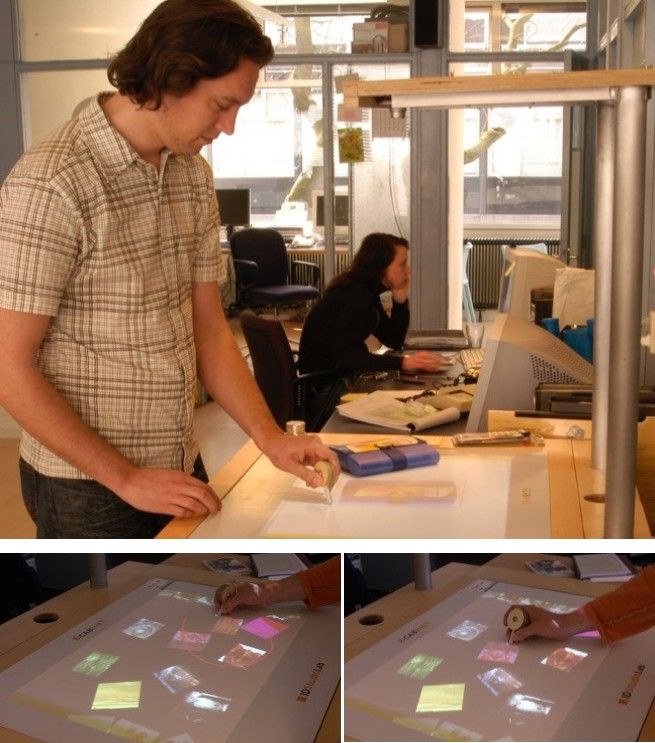
Figure 3.2 – User arranging visual materials for inspiration with the Cabinet (courtesy of Ianus Keller)
Much of what was learnt in the process spanned (connected, or fell in between) different disciplines or theories; much of the learning occurred during the making of the prototypes, and the explanations, questions, and discussions at informal presentations to lab visitors, rather than in formal experiments.
The research prototype was shown at conferences (winning a design research prize at the 3rd International Conference on Appliance Design), and the findings were published as separate studies in journals. But several of the insights that the research team found extremely valuable—such as the three ranges of interaction—turned out to be difficult to publish, because they didn’t fall into any of the available categories of journals. Again, the thesis contains essential information not found elsewhere – reflecting the point that the subject you are reading about really is edging away at existing frontiers of knowledge.
The knowledge generated in this process concerns the multiple ways creative professionals make use of visual materials for inspiration, and how they access and store these. This includes interaction possibilities of ‘sketchy’ ways of handling Virtual Reality environments, the usability of various display formats (wall, table, hand-held), and tabletop interaction formats.
A series of interactive prototypes were used, by which people could manipulate and experience visual materials for inspiration purposes.
Knowledge was generated by combining user research (interviews with domain experts and contextual studies of creative professionals about their use of inspirational materials) and iterative prototyping (with the first prototype used in the design research studio, and a final prototype tested during one-month interventions at three design agencies). Results were shared via both academic publications (Ph.D. and articles) and exhibitions.
Published in Keller 2005; described in Brandt & Binder 2007, Stappers 2007, Stappers et al. 2014.
41.2.3 Gaver’s Drift Table
Bill Gaver’s Drift Table project at the Royal College of Art is presented as an open study of how one can explore the impact and opportunities of digital technologies for the domestic environment. Gaver stresses the openness, and rejects any a priori framing, or general conclusions.
As Gaver et al. (2004) describe:
“The Drift Table is a coffee table with a small viewport showing a slowly changing aerial view of the British landscape. Shifting weights on the table changes its apparent height, direction and speed. With about a terabyte of photography of England and Wales available for viewing, the table may be used to explore the countryside, travel to a friend’s house, explore questions about geography, or simply to watch the world go by.”
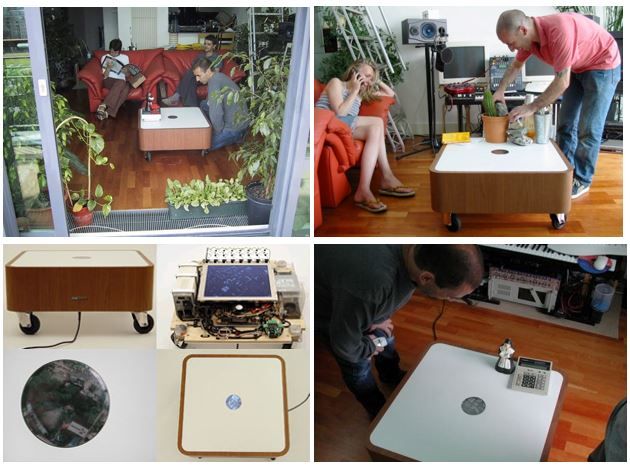
Figure 3.3 – Details and deployment of the Drift Table (courtesy of the Interaction Design Studio)
The prototype is made with a definite functionality and implements state-of-the-art technology; however, it is explicitly not grounded in user needs, a functional purpose, or an intended benefit. Rather, it is an extension of the cultural probe, a provocation from designers to participants with the intention to “be surprised, learn what can be learned…” and “a mechanism for developing new values and goals, for learning new things, and for achieving new understandings” (Gaver et al. 2003).
The knowledge generated in this process concerns new understandings of and new values for digital technologies for the domestic environment as well as principles of ludic design (as developed through practice and in tactics).
In this case, several iterations led to the state-of-the-art prototype’s being deployed in the field for ethnographic observation. Knowledge was generated by tactics developed through detailed design decisions. These accommodated opening assumptions (made explicitly to guide the design process) and changes in the team’s understandings (prompted by observing how people live with the artifact over a relatively extended period of six weeks). Results were shared via a variety of means, from academic publications to visual documentation, annotated portfolios, and exhibitions.
Published in Gaver et al. 2003, described in Zimmerman et al. 2010.
41.2.4 Mattelmäki’s Probing Kits
Tuuli Mattelmäki’s Ph.D. project at the University of Arts and Design, Helsinki in Finland aims to deliver support for empathic design approaches. In a series of case studies, carried out within different settings of industrial product development, the researcher designed and evaluated tools and techniques for engaging end-users and other stakeholders in an empathic design process. Prototypes in this study were both material (toolkits and workbooks) and immaterial (plans, scripts for conducting sessions).

Figure 3.4 – Tangible and intangible prototypes in support of empathic design (courtesy by Tuuli Mattelmäki)
Mattelmäki’s experiments explore how to design empathic probes for a specific setting, in the context of a specific design project. Each design project is an iterative process of programming (reflecting and moving forward) and conducting experiments under almost normal professional conditions. This cycling from one project to the next is not so much an accumulation or refinement of method but rather a particular design practice that is informed by recurrent iterations through a broad spectrum of different domains. In so doing, it has established its own repertoire of exemplary tools.
The knowledge generated in this process concerns empathic design, and it includes a repertoire of exemplary tools.
Tangible and intangible prototypes include toolkits, workbooks, and scripts for conducting sessions (techniques).
The work iteratively progressed through cycles of probing experiments and reflections within different domains, until an empathic design practice was informed and a repertoire of tools established.
Results were shared mainly via Ph.D. dissertation and academic publications. They were also disseminated through the embedding into and transformation of specific design practices/studios.
Published in Mattelmäki 2006, described in Brandt & Binder 2007.
41.2.5 Lundström’s Energy Visualizations
Anders Lundström’s doctoral research at the Royal Institute of Technology (KTH) in Stockholm, Sweden, concerns how to design for energy-sensitive interaction, so that drivers of electric cars can better manage energy use and consumption. Central motivation for the work is using design to investigate a previously unexplored terrain and open up a new design space (e.g., energy-sensitive interaction). This design space is thought of as containing possibly endless and worthwhile design proposals for desired interaction with future electric cars.
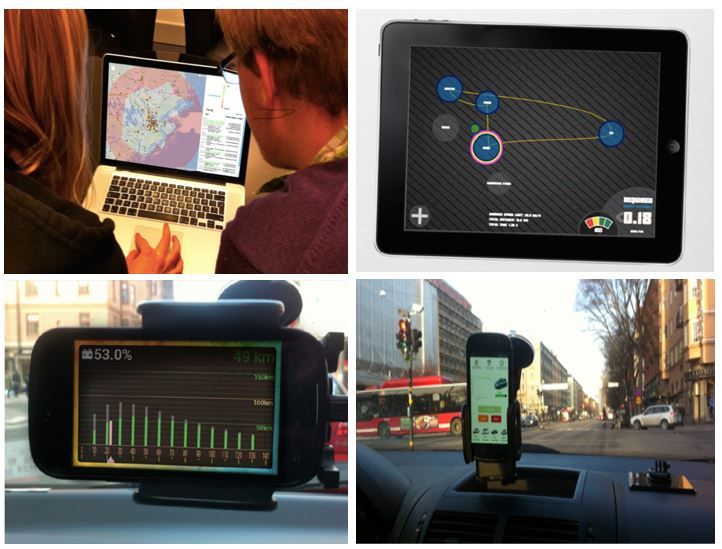
Figure 3.5 – Prototypes of information visualizations for energy-sensitive interaction (courtesy of Anders Lundström)
The work begins with a laboratory study experimenting with new aspects of map-based visualizations of driving range and then moves to research driving behavior. Later prototypes and studies gradually become focused on what are identified as the key aspects that the driver needs to understand and actively work with in order to manage the battery (i.e., the relationship between driving range, driving speed, and climate control).
The knowledge generated in this process concerns defining and operationalizing the idea of ‘energy-sensitive interaction’.
A series of information visualizations were created so as to explore key aspects that the driver needs to manage the battery of an electric car optimally.
The work progresses via a series of design experiments and studies aimed at researching explicit driving-range issues of electric cars.
Results were shared via Ph.D. dissertation and academic publications.
Published in Lundström 2016, described in this chapter for the first time.
41.2.6 Rygh’s 2.5D Material Samples
For Karianne Rygh’s research project at the Design Academy Eindhoven, in collaboration with printing industry leader Océ/Cannon, the starting point was a new 2.5D printing technique developed by an industrial partner. As with many new materials and technologies, the printing technique was promising and intriguing, but applications were not forthcoming. The reason for this was thought to be the absence of ‘inspiring examples’ for designers.
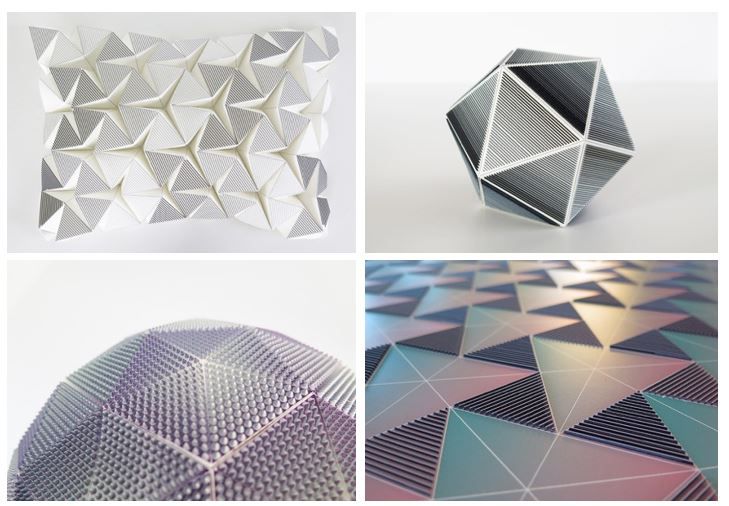
Figure 3.6 – Sample of 2.5 D prototypes (courtesy of Karianne Rygh).
Rygh set out to explore the opportunities of the 2.5D printing technique and generated numerous examples of printed surfaces, pseudo-cloth, and print effects. The results clearly impressed viewers at expositions. The question would arise easily: “Is this research? Is it design?” It was a technology looking for an application, but had neither a clear framing in theory ‘knowledge for the use of others’ or product ‘application’. But the collection can guide and inspire others; it explores and documents a solution space in the way that 18th-century butterfly collections and explorers’ maps did in earlier days.
The knowledge generated in this process concerns the solution space of 2.5D printing, namely a great variety of 2.5D-printed artifacts, exploring and expressing the new technology.
The process unfolded as a way of thinking through making. It is an exploration and documentation of examples meant to inspire others. Results were shared via rich visual documentation and exhibitions.
Published in Rygh, (2015 a,b), CRISP(2015).
41.2.7 The Wright Brothers’ Airplane
Wilbur and Orville Wright are well known as inventors of what we now call the airplane, or as they described it in their patent, the ‘heavier-than-air flying machine’. Their invention took place over a century before the other projects mentioned here, and not at a university or a design school. Yet we include them in this list of examples because they had to overcome several barriers, which they did in ways that are exemplary for designerly actions we see described in Research through Design. The most famous one is their patented invention of (i) ‘wing warping’ – i.e., deforming the shape of the wings to make the plane turn (something that was later achieved by flaps on the wings, but in their experiments meant they deformed the entire wing frame).

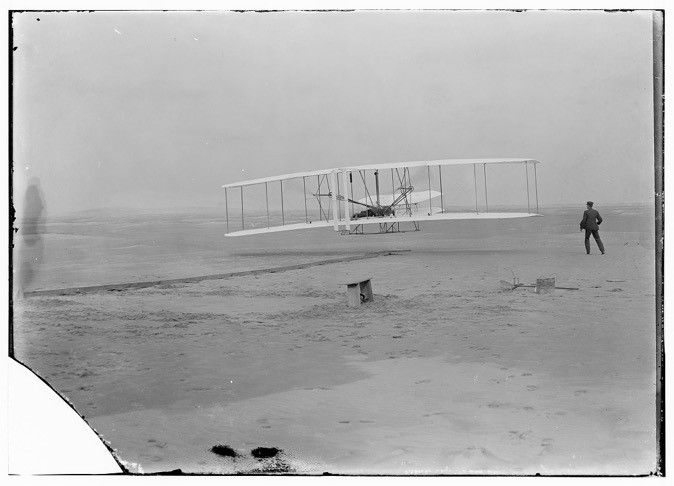
Figure 3.7 – Some of the Wright brothers’ improvements: above: the first wind tunnel prototype to compare air resistance of wing profiles, and final prototype wind tunnels (drawn after pictures on http://www.wright-brothers.org); below: flyer prototype with wing warping and human control. [Library of Congress, Prints & Photographs Division, LC-DIG-ppprs-00626]
Underlying this solution was their (ii) framing of the central problem of flight not as getting off the ground, but as being able to control the direction of movement in three dimensions. Most of their competitors had focused on achieving lift, but ignored or underestimated the problems in making turns, and making such maneuvers involved careful operation of the craft by the human pilot. By the time they achieved powered flight in December 1903, the Wrights had made extensive forays into the sky using gliders since 1900. Along the way, their project required them to (iii) study the aerodynamic qualities of wing shapes in detail, (iv) devise a theory of propellors, based on what they learnt of wing shapes, (v) construct laboratory instruments and measurement methods such as the wind tunnel, (vi) find ways to let the pilot control the plane using his body weight as well as his hands, and (vii) develop a lightweight engine and (viii) a launching catapult to assist in the take-off. Some of these contributions (i–iv) lay at the core of ‘achieving human-controlled powered flight’; others (v–viii) were sidelines, work they saw themselves forced to do to get the job done, but which were worthwhile contributions for others in their own right. Next to the practical utility and systematic and precise measurements, their reframing of the problem of flight is a contribution that lies at the core of today’s conception of design skills (Stappers & Flach 2014). In doing this, they made use of the literature that was published before (and published corrections of it), devised, built, and tested a series of prototypes (and documented their trials).
The knowledge generated in this process concerns several discoveries, including:
Aerodynamics of wing shapes
Aerodynamics of propellors
Flight framed as a steering-control rather than a lift problem
Human operator control and interaction
Testing methods for aerodynamics (wind tunnels)
Support equipment to enable experiments (lightweight engine)
Several prototypes of laboratory instruments, airplane parts, and flying airplanes were involved.
The process included empirical studies and systematic testing. The researchers carried out this variety of different tests and implementations in a program that took (only) six years.
Results were shared via demonstrations and shows, articles, patents, and tours.
Described in Bernstein, 1996, Stappers & Flach 2014, and popular online sources, e.g., http://www.wright-brothers.org/.
41.2.8 Conclusion
These are but seven examples, but they cover a large part of the variety of the ways in which RtD is done, and serve as a basis for reference in the discussion of the themes in the next section.
(Some) reported things | Research process | Context | |||
Knowledge |
Artefacts |
Learning |
Sharing |
| |
Wensween 2004 | Principles of tangible interaction. Design for emotion | Alarm Clock | Laboratory measurements and user testing (lab), experimental method | Ph.D. thesis Academic publications | Ph.D. |
Keller | Ranges of interaction Use of digital/physical sources | Cabinet (plus partial prototypes) | Goal-driven exploration, discovery, Expert interviews, User studies and interventions in design studios (field, showroom) | Ph.D. thesis Academic publications Exhibitions | Ph.D. |
Gaver et al. 2004 | Tactics for ludic design. New values for digital technologies in the home | Drift Table | Speculative, open exploration. Design tactics and one open-ended, six-week design intervention (field, showroom) | Annotated portfolios Academic publications Exhibitions | EU-funded academic project (EQUATOR) |
Mattelmäki 2006 | Empathic design approach and tools | Probes, toolkits, sessions | Case studies (field) | Ph.D. thesis Academic articles Embedding into design practices | Ph.D. |
Lundström 2016 | Energy-sensitive interaction vocabulary | Diverse | Programmatic exploration. Design experiments and user studies | Ph.D. thesis Academic publications | Ph.D. |
Rygh 2015 | 2.5D printing techniques | Collection of samples | Showroom | Visual documentation (e.g., website) Exhibitions | NL-funded academia-industry project (CRISP) |
Wright (1903) | Aerodynamics, stability, stalling Human control | ‘Flyers’ Wind tunnel Propellor and wing shapes | Invention, development, prototyping, evaluating, test flights, (lab, field, showroom) | Patents, demos, airplanes, academic and popular publications | Inventors & entrepreneurs |
Table 3.1 – Comparing the seven examples
41.3 Themes under discussion in RtD
In reflections on what RtD is, or how it should be conducted, design researchers are struggling to find the particular qualities of the contributions to knowledge that can be made by designerly experimentation. A number of questions have been discussed.
What type of knowledge is gained by RtD?
What is the role of the prototype or artifact?
Is there a particular way in which RtD projects are carried out?
How is the knowledge communicated, how does it reach its audiences, and who are these?
How does RtD relate to other ways of doing research?
Can an RtD project have design as a primary goal?
What is the academic place: where does RtD belong?
For none of these connected questions is there a final answer or even a formulation that everyone uses. Nor are all these questions addressed by all authors. In this section, we address a number of themes and models that have been discussed. Questions 1 and 2, about knowledge and prototypes, concern nouns that fit the ‘What?’. Questions 3 and 4, about learning and sharing, call for verbs that address the ‘How?’. These four themes, shown in Figure 4.1 below, are dealt with in this section. Questions 5 to 7 are about the bigger picture—namely, ‘Where does it fit in between other ways of doing research, and what is the benefit of doing it this or that way?’—and are touched upon in section 5.
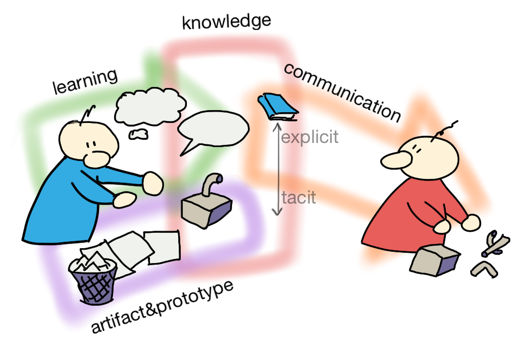
Figure 4.1 – Themes discussed in this section: at left, we see the designer(s) conducting RtD, with his reflections and explicit discussions of the artifacts below and the way they were achieved and evaluated. These artifacts can be prototypes and sketches, many of them going ‘in the bin’ and lost for communication. In the middle is the spectrum between abstract, with explicit knowledge at the top and situated, multifaceted, material, tacit carriers of knowledge at the bottom. The arrow and person on the right show how what was learned is picked up by ‘users of knowledge’—other designers and researchers—in their endeavors to produce knowledge and/or societal effects elsewhere. The wastepaper basket represents the question of what happens to lessons learnt during the making of artifacts that were never finished.
41.3.1 The type of knowledge
The concept of ‘knowledge’ has a long and heavy history in philosophy, which RtD literature has sometimes touched upon. However, given such a rich and entrenched history (encompassing many centuries and traditions), most researchers proceed with general notions without explicit or elaborate commitment to historical schools of thought. Again, the area we are concerned with here remains ‘new’ and continues to trailblaze at the cutting edge. Thus, a fitting school of thought may well have to be developed out of the concerns that are at stake.
Our working definition of knowledge as ‘understanding about the world which can be shared’ (section 2.1.1) expresses a concern that although a designer may learn a lot by engaging in a design project, this private learning, often intuitive and left tacit, should not be counted as a research result, because it is not shared with others.
A lot of discussion has addressed the questions of ‘What are the research outcomes in research through design?’, ‘What knowledge is generated?’, ‘What is or can be communicated to others?’, and ‘How can it be documented?’. Less discussed, but equally important, is ‘What has been reused and how?’. Some of these questions will be addressed here, others later in the section.
41.3.2 Abstraction and Generalization
Theories are, by definition, formulated on a high level of abstraction, so that they can be applied to many different situations (generalization), which are then presented as instantiations of the abstract notions. So, Newton’s law about the motion of ‘bodies’ can be applied to apples as well as oranges, to rockets, and to tennis balls. Closer to HCI, Miller’s (1956) Law of Seven, Plus or Minus Two (or, 7±2, where people can deal fluently with a small number of categories, but their overview breaks down when facing larger numbers) can be used for guiding the design of menus in computer interfaces, or to determine the number of personas to make to support but not overwhelm a design team. Opposite to the abstract principles are the concrete phenomena and things that we deal with in the world, where there are no ‘bodies’, only apples or oranges (more precisely, only ‘this apple’ and ‘that orange’). Making the link between the abstract and the concrete, the general and the particular, is a major skill and challenge in any research. In the scientific experimental method, researchers seek or create concrete things which can serve as ‘instances’ of their theoretical notions – i.e., they select apples and oranges to function as ‘bodies’ in a laboratory test. In the other direction, they may collect this apple and this orange and interpret them as ‘bodies’ to see how their theory applies. But these apples and oranges are also fruits, biological entities, food, colored objects, etc. Newton’s and Miller’s laws are useful because they isolate a single aspect and leave out all else. Just as an abstract concept can apply to many instances, a concrete thing carries many facets. As such, it can be studied through many different lenses.
41.3.3 Explicit (the statement is in words) versus tacit (the artifact is the statement)
There is a general consensus that the knowledge that is generated in designing is often rich and diverse, but also incomplete, open and ambiguous. Written accounts of design and use, for example, are unable to capture tacit knowledge (Höök et al. 2015). This is not to say that such knowledge cannot be communicated—rather, that it cannot be communicated by mere words. Material artifacts and experiences are deemed to be part of this communicating.
Ingold (2013) explains the distinction of tacit knowledge as a difference between knowing and telling, describing how a maker’s ways of knowing and doing are told ‘by hand’. The artifacts, especially prototypes, are said to be carriers of such knowledge. Aligned with this position, some state that the prototype itself is the knowledge, but few will agree that ‘this apple’ by itself will be able to tell that it is ‘a body’. Such a framing has to be added explicitly.
Textual and visual accounts in RtD (published papers, documents, descriptions, catalogue entries, pictorials) point to features of artifacts of interest to highlight them and make them topical for discussion within a given community. These texts can be seen as annotations to the physical objects depicted in them (Gaver & Bowers 2012) rather than the physical objects being an instantiation of the abstract concept denoted by text. Bowers (2012) brings in Wittgenstein’s (1953) notion of categories defined by ‘family relations’, where between each pair of members of a category such as ‘game’ there is a similarity that is easily described, but no overall single rule can be given about the properties of the members. The role of these text-depiction combinations then is to explain and string design examples into a coherent body of work, instead of replacing them with theory.
41.3.4 An intermediate level in between abstract theory and particular artifacts
With the growing popularity of Research through Design (RtD) in HCI and IxD as a valid research method in the field, there have been different proposals of intermediary forms of design knowledge (Höök et al. 2015) – that is, forms of design knowledge that sit in between things-in-the-world (‘instances’, actual designs, ultimate particulars) and abstractions (theories, generalizations). These mid-level solutions concern how to articulate, validate, and constitute the knowledge gained through design research. Forms of intermediate-level knowledge can range from single design solutions (Stolterman 2008) to annotated portfolios (Gaver & Bowers 2012) to strong concepts (Höök & Löwgren 2012), to criticism (Bardzell et al. 2012) and operationalizations of general theory (Lindwell et al. 2003).
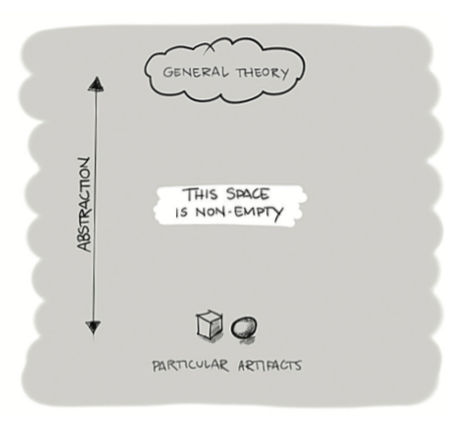
Figure 4.2 – Abstraction as a general-to-particular dimension (Löwgren 2013)
A single concept design can be seen to serve theory as an instantiation—i.e., the fact or act of providing a specific example or application—of a more general theoretical notion, and it can be influential on subsequent research in the field and future designs (Stolterman & Wiberg 2010). The concept design of the Dynabook, for example, was influential in HCI and computer science. Proposed by Alan Kay and colleagues at Xerox PARC in the early 1970s as a vision of future personal computing in the context of children’s learning, Dynabook embodied notions of constructivist learning in a concrete form, which “would not let itself be categorized as either instance or theory” (quote from Höök & Löwgren 2012).
A step further is the notion of a strong concept (Höök & Löwgren 2012). A strong concept is a form of intermediate-level knowledge that is more abstracted than particular instances and that plays a direct role in the creation of new designs. The authors describe ‘social navigation’ as an example of a strong concept. Social navigation refers to the idea of making the collective or individual actions of others visible so as to aid users to navigate information spaces and make decisions on where to go next and what to choose. This idea has been used and appropriated in a variety of design situations. An additional, simpler example is the slingshot touch interaction in the Angry Bird app, now used in a wide range of touch-interface solutions from casual games to communication between Bluetooth-paired devices.
However, extracting knowledge from specific designs via intermediary design knowledge cannot and should not replace the need for specific design examples and for design critique (as in architecture) (Höök et al. 2015).
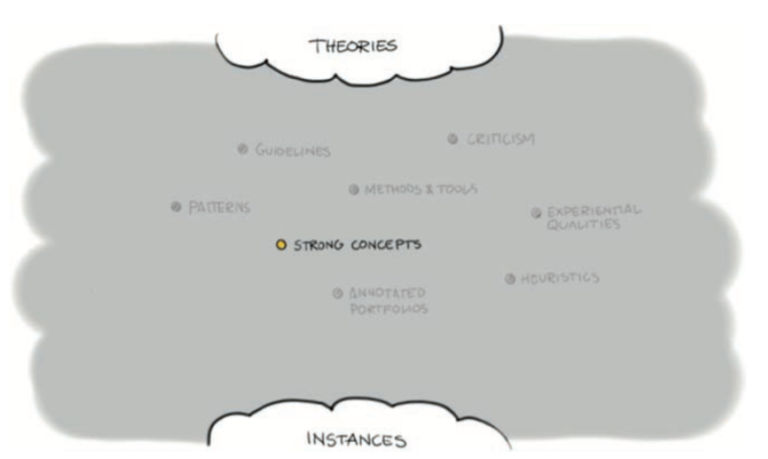
Figure 4.3 – Höök & Löwgren 2012, p. 23:2 present several forms of knowledge that lie between the abstract (theories) and concrete objects (labeled instances when they fit the theory).
41.3.5 Multiplicity of artifacts and framings
Gaver and Bowers (2012) argue that middle-level knowledge can be filled by a connected group of example designs and annotations framing them. This connects to Wittgenstein’s (1953) notion of collections of objects that have a family resemblance – i.e., they form a single group, but the group cannot be defined by a single rule; nonetheless, each pair of group members shares certain traits.
Gaver explicitly takes a position against generalizing, or the hope of extracting generally applicable knowledge, just as action researchers have disavowed claims for general validity of what they found to be working in one situation (Gaver 2012).
Depictions of a collection of artifacts and annotations can be made to form a portfolio, bringing together individual artifacts as a systematic body of work. Typically, a portfolio can be annotated in several different ways, reflecting different purposes and interests and with different audiences in mind (Bowers 2012). For example, Bowers (2012) analyzes the artifacts in the portfolio of the Interaction Research Studio under eight themes, each concerning a different kind of interaction and engagement fostered by the design. Other annotations are articulated in Gaver & Bowers 2012.
Annotated portfolios (Gaver & Bowers 2012; Bowers 2012; Löwgren 2013) are a collection of multiple designs by the same or associated designers. They define/establish an area in the design space. Annotated portfolios allow one to compare different individual items, the relevant dimensions of their design domain, and the designer's opinion about the relevant places and configurations to adopt on those dimensions. Figure 4.4 was used to exemplify the way in which multiple designs and annotations convey knowledge about a design style, information which could not be carried effectively with mere words or pictures alone.
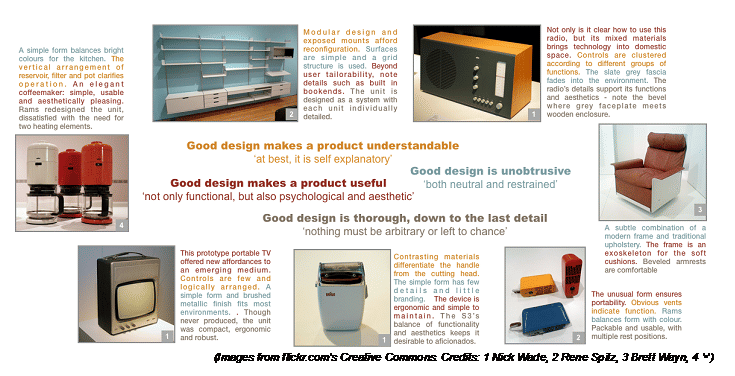
Figure 4.4 – Annotated portfolio illustrating the style of Dieter Rams (from Gaver 2012)
The collection and benchmarking of design products made with the intent to frame and reframe possible design solutions, themes or spaces or the collection and framing of material explorations (Karana et al. 2016, Tsaknaki et al. 2004) serve a similar form of intermediate knowledge production.
In a ‘traditional’ (positivistic) scientific account, such text-and-depiction combinations as found in Figure 4.4 are regarded as, at most, illustrating the theory. However, here, these combinations are presented as the definition of an abstract theoretical notion through the telling of examples, with the claim that a precise, abstract notion is probably unattainable.
41.3.6 Designs as an illustration or statement of theory
Finally, design artifacts have been used as—even made especially for—illustrations of theoretical notions. Designers’ and artists’ visualization skills have been recognized before in this capacity. The contributions of the person making the visualization vary from merely assistive illustration to provocations to theory. The mathematical visions of the artist M. C. Escher (such as his infinitely rising staircase in Klimmen en dalen, 1960; see SchattSchneider, 2010) and the philosophical challenges presented by Magritte (La Trahison des Images, 1929, better known as “Ceci n’est pas une pipe”) are examples where the artifacts of the artists have given direction to the mathematical or philosophical discussion.
On a smaller scale, in early design research experience, notably in perception research, design students’ skills were often used to create visual materials to fit the hypothesis that the psychologists defined (described in Stappers et al. 2014). Designers could make better stimuli, better pictures to show participants in studies. At first, the contribution of the design students was to give expressiveness and recognizability (line drawings in psychology experiments were often of poor graphic quality). However, as the research questions became more design-focused, students began to challenge not just the graphic quality of the stimuli but the limitations of the relevance of the research variables, too. Repeatedly, they came up with examples of stimulus designs which by their very form questioned the validity of the choice of variables. The value of designers in the research team lay in their ability to deal with the complex nature of material things and to deal with the other lenses and facets that happened to lie outside of the field of view of the leading theory, outside the isolated variables.
41.3.7 What is the knowledge ‘about’?
Because a ‘thing-in-the-world’ has multiple facets, many of which need to be addressed simultaneously in doing design, it is likely that the designer will learn about many things, such as:
The prototype he is making (“We need it to be lighter so as to be portable.”)
The technology he uses to make it (“These bluetooth transmitters can be used if they are boosted by aligning them up to boost their signal.”)
The interactions between his prototype and people (“They give up after three trials.”)
The people who interacted with his prototype (“They won’t use it during a conversation with others.”)
The knowledge/technology domains relevant to the realization of the prototype or the understanding of the phenomenon under study (“We may need creativity theory to develop this interaction.” – e.g., Figure 4.5)
How the designer went about doing the designing (“I had to abandon three lines of inquiry, only to return to my original idea with a different technology.”)
The trust she has in the feasibility of a solution or principle (“This one-click interaction doesn’t distract the user.”), and
Its generalizability (“We can use that again for other problems.”)
How the research was done and how it could be done better (“For our next study, we’ll have the video records transcribed before we start analyzing ourselves.”)
Some of the insights are new to the designer, some may be new to the domain in which the work is situated, and some may be new to the disciplines to which it is related. The degree to which that knowledge is reused (by the designer, or someone else working with him), shared (possibly taught to others, through experience or explanation), or even captured (written down and explained in words, images, video) will vary. Much of it will not remain conscious, but will evaporate unless it is captured and shared (Stappers 2007; see section 4.2, Figure 4.6 and section 4.4).
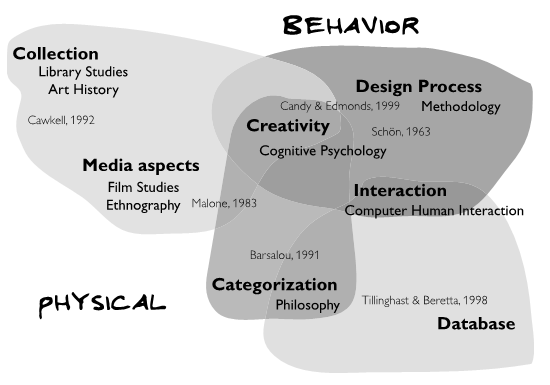
Figure 4.5 – A sketch of knowledge domains that were considered relevant for the development of Cabinet, from halfway through Keller’s project (2005)
41.3.8 Knowledge about the artifact, and ‘design knowledge’
In a way, design knowledge can be said to reside in the artifact (Cross 1999, Ingold 2013). But as mentioned earlier, that is deemed problematic, because ‘by itself’ the artifact may not convey this knowledge to others. This limitation is illustrated by the common experience of left-behind prototypes in our labs, whose original purpose, function, and value have left with their makers without these three key elements’ being captured and shared. Cross’s notion of design knowledge as being a special kind of knowledge, privileged to professionals in the arts and design discipline, suggests that there are limits to which design knowledge should be thought of as existing outside of the maker of that knowledge and transferable in the first place (see section 4.4).
The experiential, often tacit knowledge obtained through engaging in design activities, and made of subjective insights and understandings pertaining to particular situations, is crucial to design practice (Schön 1983). But there is a need in RtD for further articulating “knowledge about the object that is being designed, the situation into which it will eventually be introduced and the process to establish a proper fit between the two, the acts and considerations of designers, and the interrelations among all these components” (Höök et al. 2015).
If the ‘about’ is a domain already existing outside the design, the results may fit in those domains, possibly in pre-existing framings, and possibly challenging or adjusting those. This occurs when the designers create stimuli for a client psychologist’s brief and the design activities and artifacts are merely a means to gather information or to test a hypothesis framed in the client’s theories. It can also occur when design is used mainly as a different way to contribute to an existing domain – e.g., by discovering consequences of realizing a potential future in a prototype. But if the design part is merely an outsourced production activity, rather than an integral part in the creative cycle of the research, it would not be regarded as RtD but as Design for Research instead.
41.3.9 The role of the artifact
Designers make things: sketches, models, plans, visuals, prototypes, products. All of the literature sees these as essential ingredients of Research through Design. Especially the prototype—i.e., the embodied, materialized concept design (rather than an early sketch, diagram, or wall-with-post-its)—is seen as playing an essential role in Research through Design. Although the material aspects are important, increasingly though, the object that is prototyped is not necessarily conceived as a material object (although it may be facilitated or supported by one), as in prototyping a service or a (design) method, technique or practice. Zimmerman, Forlizzi, and Evenson (2007) write:
“…we build on Nigel Cross’s idea that design knowledge resides in the product (Cross, 1999). The artifact reflects a specific framing of the problem, and situates itself in a constellation of other research artifacts that take on similar framings or use radically different framings to address the same problem. These research artifacts provide the catalyst and subject matter for discourse in the community…” (p. 499)
Prototypes play a number of important roles in doing design. At the “Prototype: Craft in the Future Tense” symposium, eleven researchers from very different disciplines discussed various aspects of prototyping, namely that prototypes are:
Unfinished, and open for experimentation
A way to experience a future situation
A way to connect abstract theories to experience
A carrier for (interdisciplinary) discussions
A prop to carry activities and tell stories
A landmark for reference in the process of a project
(Stappers 2013)
Stappers (2007) stresses the confrontational character of the act of making the prototype and ‘getting it to work’, within the world of ideas (sketches, visions, competing or conflicting theories, speculations), with the world-out-there (physical and social possibility), and in connecting these two worlds (tests and constructions), and confrontations between researchers and between researchers and other stakeholders (see provocations).
A single prototype can function as the proof that something which was previously held impossible actually is possible, as in Thor Heyerdahl’s crossing the Atlantic Ocean on a self-built papyrus boat, proving that transatlantic crossings were possible with ancient Egyptian technology. This is similar to the proof-of-concept prototypes made in conventional design practice. However, it is often overlooked as a means of proof in academic research methodology. Similarly, since the 1930s the automotive industry has engaged in creating ‘concept cars’, one-off productions to show the possibility of using a new technology or designing for a new area of application. These are more than just aesthetic experimentations for new commercial products, making these prototypes help companies to learn about new technologies, understanding future changes, discovering market opportunities, and improving their creative problem-solving capabilities. They are used to guide a company’s design direction so as to engage with the public more profoundly (Mejia 2016).
41.3.10 Does the artifact ‘speak for itself’ or ‘explain a theory’?
Prototypes and other artifacts designers make certainly have an important influence on people. Their tangible qualities draw attention and spur the imaginations of many, as expressed by the motto “Always bring something to drop on the table.” (attributed to David Kelley).
The physical prototype serves several functions related to knowledge. It can illustrate or instantiate abstract theoretical concepts, and it can demonstrate the possibility of a new combination of elements. Some say that the prototype itself is the knowledge or that it carries the knowledge (Mäkelä 2007). There is disagreement about this. The objection that is made is that the prototype does not tell its story all on its own: Wensveen’s clock was mistaken for a consumer product; Keller’s image-entry system decision was not apparent to a visitor. To get insight from a prototype, the beholder needs to have a framing, to recognize which aspects of it are meaningful and which are contingent (i.e., which might as well be different). The limitation of ‘what is’ is just that it ‘just is’. Within a close community of professionals, the meaning of a prototype may not need to be made explicit, because these people share implicit values, and will recognize what the salient characteristics of a prototype are. But this relays the burden to the question “Who is part of the in-crowd?”, which is something that science tries to avoid. This shows the tension between professional practice in the arts and crafts—where the master craftsmen (especially within the confines of the guild) will have a shared, but tacit, framing of the world—and science (and engineering) – which want to create an explicit, but abstract, generalized framing in order to share the insights in a broader community. Part of the differences of opinion about how much explanation should go with an artifact lies within these different values and paradigms: does the artifact ‘speak for itself’ or not?
Moreover, some of the best insights come from our failures, from prototypes we do not finish, and they may not leave a trace like the successes do. These insights may not have a simple publication or exhibition where one can go back and find them – they sink into obscurity, along with the treasure they carry.
41.3.11 ‘Research prototypes’ versus ‘concepts for products’
The prototype, as a thing-in-the-world that was made by a designer, is easily confused for an everyday product that is intended for the consumer market. This was the case in theory- or discovery-driven RtD approaches, like with Wensveen’s clock, where time and again people asked, “Isn’t all that interactive technology a bit expensive for an alarm clock?” and, “When will it come out?”; similarly, for Keller, visitors to the lab, enthused by the cool demo, asked, “When can we buy it?”. Frens (2006, also discussed by Koskinen et al. 2011) created a series of highly aesthetic prototypes of cameras, to validate the possibility of certain interface design criteria, and tested these under controlled conditions to ensure the link back into theory. Wensveen and Matthews (2014) discuss two uses of prototypes that fit into ‘conventional’ scientific methodology without difficulties: the prototype as a means to test a hypothesis, where the prototype is made to instantiate selected variables, and the prototype as a measurement device to produce data for analysis. Both of these have a larger history in scientific traditions (e.g., see 5.4; Wensveen & Matthews also discuss two other functions of prototypes: illustrating abstract theory, and giving direction to research).
In each of these cases, the researcher/designer put great effort into creating a prototype with a desirable aesthetic that looked as if it could be a product. The reason they give for this is that that is necessary for the user interactions to be relevant (ecologically valid). But with this convincing interaction comes the expectation of the visitors that the prototype is intended as a commercial product.
These expectations are used as a resource in more recent inquiry-driven RtD approaches that aim to investigate complex matters of human relationships with technology over time in the intimate and contested contexts of everyday life. Here, the notion of a ‘research prototype’ may not be fully sufficient to support these kinds of inquiries, and that of ‘research product’ is preferred (Odom et al. 2016). These are artifacts where the quality of finish is bound to the artifact’s resolution and clarity in terms of its design and subsequent perception in use.
None of these examples was intended to become an actual product. The design decisions made in them are often made for research purposes rather than for end-product purposes. Wensveen states he never intended an alarm clock with 12 sliders to become a feasible (or even desirable) product. Keller (2005) found that at certain points design decisions were made against usability factors in favor of research factors: users could load digital images into the cabinet prototype not through a direct (ethernet) connection but only by the explicit action of entering a USB stick. The former would have made it easier for users to upload a lot of images. The latter was preferred, because it made adding images an explicit and observable social ritual. Similarly, the artifacts presented in Odom et al. are designed to ask particular research questions about potential alternative futures. They embody theoretical stances on a design issue or set of issues.
No such confusions seem to have bothered the Wright brothers. Their prototypes were clearly technological trials. And their contributions to the science and engineering of flight (at least those that are remembered now) fit into established domains: aerodynamics, control theory, human factors. The reason for the confusion with Wensveen’s and Keller’s prototypes may be that their research topics were close to interaction design practice, and their research needed high-fidelity interactions to be convincing, which in the end made them look more like product prototypes than research instruments.
41.3.12 Prototypes as themselves giving direction to the research
Prototypes can give direction to research by embedding and being the primary means to ask particular research questions. They can be used in the unfolding of research, with the goal of either substantiating it or challenging it (Brand et al. 2011, Smith et al. 2016). In this sense, they can have different purposes and generate different knowledge. They can help open up a not fully unanticipated design space (Giaccardi et al. 2016, Mazé & Redström 2008). They can be a vehicle for theory building (Koskinen et al. 2011, Stappers 2007, Zimmerman, Forlizzi & Evenson 2007, Wensveen & Matthews 2014). They can help establish critical areas of concern and judgment (Gaver 2012). Often combined with mock-ups and co-design tools such as design games, workshops and scenarios, they can also generate contextual knowledge and lay out directions for design opportunities that evolve around lived experiences (Halse et al. 2010, Sanders & Stappers 2012). The goal pulls the design forward, while physical manifestations play an important role in the inquiry and in shaping the direction and arch of the research.
| The big upward arrow depicts the design goal that drives the effort. The spiral is formed by the iterative prototyping actions which progress along the direction of the design goal. All along the way, new knowledge has to be put in, and some (but not all) learnings can be spun out. The project starts on a mixed basis of background knowledge (including the experience of the people involved and the literature that is consulted). |
Figure 4.6 – Research spiral (Stappers 2007b, p12) | |
The spiral design goal (‘make a way to sort images by hand’ in Keller 2005) gives direction to an iterative prototyping effort starting from what is known, moving up into a new future; all along the way, knowledge enters from various facets (technology, people, business, method), and can leave, mediated either through experience with the prototype (first-hand) or through publications (second-hand). The example of the Wright brothers in section 3.7 shows that they learned about the state of the art in science and engineering around various aspects of the problem ‘how to create a heavier-than-air flying vehicle’, and pushed that state of the art in several of these aspects (aerodynamics, human control).
41.3.13 Prototypes as filters and manifestations
Prototypes can help designers reflect on their design activities (evaluative role) and explore new design spaces (generative role). In this perspective, prototypes can act as both filters and manifestations (Lim et al. 2008, Wensveen & Matthews 2014). When prototypes are used as filters, “the designer screens out unnecessary aspects of the design that a particular prototype does not need to explore”. This allows the designer to focus on particular regions within an imagined or possible design space. “Designers may purposefully do this so that they can extract knowledge about specific aspects of the design more precisely and effectively. The decision of what to filter out is always based on the purpose of prototyping.” These aspects are then manifested in the prototype. For example, a two-dimensional prototype of a three-dimensional building can help us to determine the spatial relationship of the rooms, without placing any constraints on the materials used for walls and floors. (The notion of filtering as an explicit act is similar to the technique of ‘isolating variables’ in laboratory experiments: a conscious effort to focus attention and limit variability in the inquiry in order to make certain things stand out better.)
41.3.14 Prototypes as provocations
Artifacts, such as sketches and videos, can also be deliberately provocative. Provotypes expose and embody contradictions around an area of interest to generate alternatives (Mogensen 1992). This can be done via collaborative analysis and collaborative design explorations across stakeholders (Boer & Donovan 2012). For example, The ‘Indoor Climate and Quality of Life’ project brought together stakeholders from five indoor climate-related companies in the building industry, a multidisciplinary team of university researchers, and five participating families (Boer & Donovan 2012). Within the context of this project, provotypes were developed to call forth what the involved families and industrial partners valued in indoor climate systems. Twist-Vase and Render Lamp were used as technology prototypes to provoke people to reflect on themes concerning indoor climate comfort through their responsive behavior.
Not all provotypes are prototypes in the sense that they realize a new future situation, but many of these artifacts are sufficiently expressive depictions of possible future situations that they can be reflected on ‘as possible new futures’. In line with critical design approaches (Dunne & Raby 2001), provocations in an RtD process can be sought also to disrupt or transgress social and cultural norms and thus stimulate discussion and debate. For example, the Significant Screwdriver (Bardzell et al. 2012) is a screwdriver to be used in the home which would record and visualize data about who used it and how it was used. Similarly, the Whispering Wall (Bardzell et al. 2012) is a sound display which would capture and play content about the opposite sex in the locker room. Again, these speculative artifacts were not intended to be mass-produced and sold, rather to provoke people to a response – as we can see, some compelling insights can come from such devices.
Speculative artifacts or fictional artifacts can be used as prototypes also to reflect on our own world and to generate alternative possibilities or possible worlds within a critically oriented RtD process (Wakkary et al. 2015, Wakkary et al. 2016). These types of artifacts often use ambiguity as a resource to support multiple interpretations and meanings (Gaver et al. 2003). Examples of speculative artifacts are counterfunctional devices (Pierce and Paulos 2014, 2015). Counterfunctional devices inhibit or remove common or expected features of a technology. An example is the Inaccessible Digital Camera, where the SD card with stored images is accessed by sawing and breaking apart the basswood enclosure. Unaware objects (Wakkary et al. 2015, Odom & Wakkary 2015) are also an example of speculative prototypes. For example, The table-non-table is a slowly moving stack of paper supported by a motorized aluminum chassis. The table-non-table is designed to operate entirely unaware of its owner’s presence or actions and provokes a range of speculations as participants attempt to make sense of its purpose and place within their homes. While one may say that such artifacts work against themselves from a functional point of view, these works point past that point toward the bigger picture of what these items say about the manifold possibilities reality offers.
41.3.15 Intangible prototypes: experiences, services, and practices
Material artifacts draw much attention, and serve as carriers for knowledge, but their meaning as research tools lies in the way they are framed. This is especially visible when the discourse is at the level of intangibles, such as experiences, services, and practices. When the aim is to bring about or sustain an experience, as in experience prototyping (Buchenau & Fulton Suri 2000), many of the material properties are mere choices of convenience, not the essence of what is being prototyped. This similarly holds when the things being prototyped are services or practices (Kuijer et al. 2013).
This is especially the case when design techniques or processes are being prototyped and tested (e.g., Mattelmäki’s (2006) probes and Sleeswijk Visser’s (2009) contextmapping techniques). The end results include a way of going about how to learn from end-users and other stakeholders, the toolkits and workbooks made to be used in specific cases, and design guidelines supported by rich case descriptions. See ‘Design tools’ below for more discussion.
41.3.16 Data-enabled prototypes
Changes in computing and communications technologies have begun to emphasize that the flow of data exchanged between people, technologies, and products is also a design material. As ‘doing design’ moves towards data technologies, and industries begin to explore quicker cycles of research and design, we anticipate this will lead to an increased use of data-enabled prototypes as research artifacts – for example, prototypes collecting and exchanging large amounts of sensor data with databases and services in the cloud or even capable of integrated machine learning analysis. Data exchange will affect the process that such prototypes may facilitate, and the way in which knowledge is produced, shared, and fed back into the design process. Iterations will be potentially faster, and more importantly will collapse the traditional division between user interaction, design participation, and the creation and distribution of products and services (Giaccardi 2017, Giaccardi et al. 2016).
41.3.17 Design tools, techniques, and methods as prototypes
Describing research can become very confusing when the object of design is a design method in itself. Yet it is important because, not surprisingly, those who develop design methods may want to do that in a designerly manner.
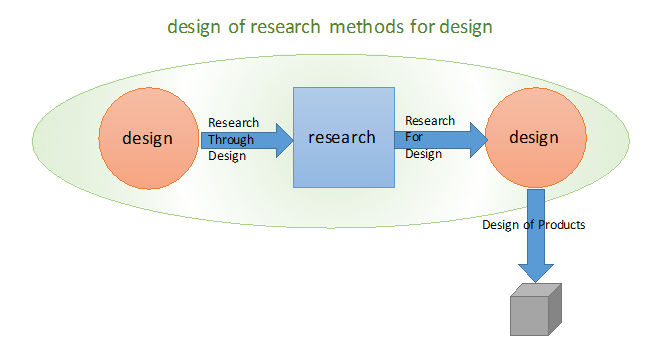
Figure 4.7 – Design activities feature at two different levels in the development of design methods. They form the object of study (on the right), and they can be part of the way the research is conducted.
In the work of Keller (2007) and Lucero (2009), the goal of the projects was to develop techniques, tools, and methods to help designers at being more creative. For Mattelmäki (2006) and Sleeswijk Visser (2009), it was to support design researchers and designers involved in codesign. In this type of research, ‘designers’ appear in many roles: as researchers developing the tools, techniques, and methods; as beneficiaries using these; as explorers not only of these tools but also finding out how the exploration should be done, learning about what types of evidence count for what, who needs to be convinced of what, etc. In an attempt to clarify this conclusion, Stappers and Hoffman (2009), as well as Stappers and Sleeswijk Visser (2014), propose a hierarchy of meta-levels in which activities occur simultaneously, sometimes involving the same actors. At each level, there is an artifact/prototype/product plus someone who is designing it and someone who is using it. The terms ‘designer’ and ‘user’ are then reserved to express the relation of actors to that artifact, rather than as an indication of someone’s skill set, profession, or education. So, the design professional can be the ‘user’ of a design tool, and a design researcher was the ‘designer’ of that tool. This relation between using and designing can be repeated in both directions, with the design researcher being a user of a research tool (and so on), and—in the other direction—an end-user using the designed product for creative purposes.
This ordering into layers helps to clarify some of the confusion, especially about the roles of artifacts and people. But it also oversimplifies the problems, assuming a simple, bounded ‘the knowledge’. If one were to include all aspects of knowledge that play a part (see section 4.1, ‘What is the knowledge about?’), a single linear ordering would not suffice; nevertheless, it remains doubtful as to whether such a more complete ordering is helpful.
|
The red triangle indicates the relation ‘designer’-‘product’-‘user’. |
Figure 4.8 – Meta-levels in design research. At each level of this diagram, the ‘actor’ role in the middle designs, develops, or produces a ‘product’ result shown on the right in his level, and as a tool in the level of its ‘user’ below. Each level comes with its own paradigms, framings, and publishing community in the ‘discourse’ on the left, and the ‘environment’ and other tools in the middle. A single person can have many of these roles at the same time, and can learn from and give feedback to the discourse in (some of) them, depending on the opportunities. | |
41.3.18 Learning: The way research is done
Regarding activities, method, and process, there is great variety by which designers go about doing Research through Design. Several authors (Mattelmaki & Matthews 2009, Wensveen & Matthews 2015) remark that there is no clearly defined singular method by which RtD is conducted. Often, the difference is explained by offsetting RtD to research activities such as usability testing, for which standardized protocols exist. But, as with paradigm-shifting research in Feyerabend’s (1993) view, qua method it seems as though ‘anything goes’.
Most authors in the field are comfortable with Archer’s (1981, cited in Cross 1999) definition of research as "systematic inquiry, the goal of which is knowledge”; however, there are considerable differences of opinion on how ‘systematic’ it can be. Many studies using RtD are exploring, holding out hope for serendipitously discovering that which is unexpected but valuable (Keller 2005). Sometimes, research findings in RtD are derived from the realizations emerging from the design process (Fernaeus et al. 2008).
Another way of using design in RtD is to use the design as the basis for a (user) study, ranging from user studies on designs (Bourgeois et al. 2014) to designs aiming to provoke thoughts and reflection (Bardzell et al. 2012).
41.3.19 Activities: what we do
Activities in RtD include the following, among others:
Conceiving and producing a prototype and reflecting on the design decisions taken
Deciding, reflecting, and discussing aspects of the prototype between those involved in making it
Discussing the prototype in a design crit with peers, to discuss how it brings clarity to the research goals
Demonstrating the artifacts in formal and informal settings, during labtours, demo hours, and expositions, and engaging (or not) with the audiences’ responses
Deploying the prototype in a field study as a means to record contextual/situational data or input from people (including data technologies)
Using the prototype as a provocation, both about the artifact and around the part of people’s lives that it addresses
Using the prototype as a ‘physical hypothesis’ to prove the feasibility of a proposition
Using the prototype as a stimulus in the testing of an overarching theory for which it constitutes an instantiation
Using the endeavor of realizing an effect through prototypes to give direction to and demarcate the research project as a whole
Confronting different framings/theories with each other and with the situation through creating an intervention
This list is already long, and we don’t claim it is complete, or even precise. It serves to illustrate some of the activities (and their purposes) that designers/researchers engage in during a study, with the intent of generating knowledge. The literature is often not outspoken about how this is done in detail; often it is ‘bracketed’ as this: “That’s methods; let’s move to discussion.”
41.3.20 Goals: why we do it
As mentioned in section 4.1, the knowledge that is aimed for by activities such as experiments may concern various aspects. Which ones are taken into account can be a matter of choosing a framing (see also section 4.2, ‘What is the knowledge about?’).
Gaver & Bowers (2012) mention
The functionality of the design (What should it do?)
The aesthetics (What form and appearance should the artifact take?)
The practicalities of its production (What materials, skills, and tools are needed to make it?)
The motivation for making it (Why are we doing this? What are we trying to show?)
The identities and capabilities of the people for whom the artifact is intended (What will our users make of this? How can we best design for them?)
Hook et al. (2015) add:
“knowledge and insights that concern aesthetics, design skills, designerly knowledge, politics, values, and other intangible key ingredients in IxD practice”
Neither list is complete, but it is worth noticing that most of the literature in RtD does not explicitly describe what the knowledge is about, what it is, and how it is used. Often, a general reference to ‘design knowledge’ is given, without further clarification as to what that knowledge is about.
If the goal is an area of ability, such as ‘managing images for inspiration’ in Keller’s Cabinet study, the sequence of prototypes’ aim is to support the activities of collecting and organizing images for the purposes of design inspiration. The group in which Keller did his research had a history as well as a set of values of designing interfaces which were rich and sketchlike in visual and interactive qualities (e.g., pioneering interfaces with only visual and no verbal elements – two-handed interactions). This functional goal and interaction style values formed the programmatic nature of the sequence of activities in the project (Brandt & Binder 2007).
41.3.21 Process: how we structure it
An RtD process can be as simple as a collection of examples, or it can be structured into an explicit program. In between are ways of working that move from single instances to more complex sets of design explorations.
41.3.22 Accumulating a collection of examples
One straightforward strand is to research new areas and technologies. Here, a large series of short explorations is conducted, sometimes explicitly limited only by the available time, and each of them provides a landmark in the ‘design space’ of feasible, valuable combinations. Rygh’s super-maker example in section 3.6 illustrates the value of creating a large, varied, but not necessarily structured collection of samples to inspire designers about the possibilities of a new technology. In Stokes’ classification of research types (section 5.3), this resembles Linnaeus’ and Leeuwenhoek’s activities of building collections without an explicit theory or application goal.
41.3.23 Iterating on successive prototypes
Several authors address the iterative nature of design as playing a part. E. Zimmerman (2003) warns against ‘the design running ahead of the iterations’, a warning from design practice against premature optimization of individual elements that may have to be reversed later because of pressing findings in other parts of the design (in line with Donald Knuth’s statement that “premature optimisation is the root of all evil”). Documentation of such earlier steps may convey many valuable lessons, but it is not easy to produce. Probably, as Figure 4.6 illustrates, many of the earlier ideas ‘end up in the bin’. Many researchers show precursors to their final design, but do not often go into detail about what was wrong with or learnt from the precursors, whereas these may have been the crucial lessons to learn. (N.B. Academic publication is not kind to learning-from-failure as a method, although it may be appreciated when it is the core topic of a publication.)
41.3.24 Following the experimental scientific method
A second approach is to embed the design actions within the research methods of adjacent disciplines—e.g., experimental psychology—that have been used. Here, theory is leading the process, and the variables in an experimental hypothesis drive the design of the prototype. This is seen in Wensveen’s clock (3.1) which allows measurement of expected patterns of action, and in the refined prototypes of Frens, who uses them to test very specific hypotheses about their use, framing the research in terms of independent and dependent variables (see Figure 4.3). Theoretical concepts are selected and brought in, and hypotheses are generated and then tested under strictly controlled conditions, and evaluated using statistical means. In this approach, Keyson and Bruns-Alonso (2009) propose experimental measurements as a required part of prototype studies, in line with Zimmerman et al.’s (2010) advocacy for more incremental theory formation.
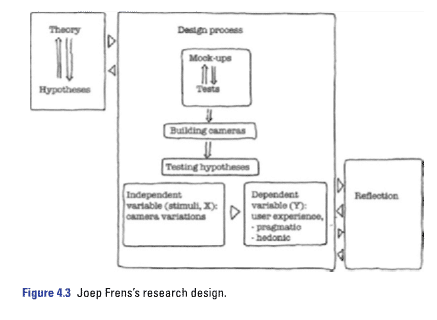
Figure 4.9 – Frens’ research design (from Koskinen et al. 2011; note the similarity of format with the arrows of Figure 7.2, with theory-driven inputs on the top left, and practice-based reflection on the bottom right).
41.3.25 Pursuing a program
Method is most clearly present in the programmatic approaches, where an overarching goal is defined for the RtD project (Bang & Eriksen 2014, Brandt & Binder 2007). In these inquiry-driven approaches, prototypes are part of experiments meant to explore and open up new design spaces.
In this approach (Binder & Redström 2006, Redström 2011), three levels of structure are distinguished. The overall structure, “Program”, defines the area of exploration (and the overall goal of the activity). Within that, “Experiments” are the concrete activities such as producing and field testing a prototype. And “Question” refers to the overarching research question that guides a research project. It is through the combination (iteration) of experiments within the program that the research question is addressed and knowledge is attained. Visualizations, as in Figure 4.10, attempt to clarify the relations between elements of question, answer, and program.
Redström (2011) characterizes experiments as (a) exploratory – that is, they initiate, drive and frame the research at the beginning of a research program (or inquiry). (b) They can be testing experiments, causing a reframing or consolidation of the research program. (c) They can be closing experiments – that is, assisting in positioning and contextualizing the research program by demonstrating its main claims. Here is where contributions to knowledge and theory developed are consolidated and disseminated.
|
|
Figure 4.10 – Visualizations of programmatic RtD processes in (Bang & Eriksen 2014) and (Hermans 2015) | |
41.3.26 Formulating a conceptual framing and filling it with explorations
Similarly, based on their experiences of conducting design-led research projects with a design-methods goal, Stappers, Sleeswijk Visser, and Keller (2014) attempt to distill guidelines for conducting a program-based (see section 4.4) Ph.D. project using designerly actions with an emphasis on discovery and evaluation.
Stappers, Sleeswijk Visser, and Keller (2014) reflect on two successful Ph.D. projects which were guided mainly by a design goal. Their aim was to come up with guidance on how to ensure that a series of design explorations delivers at least one coherent set of findings toward theory formation. In Keller’s case, the research goal was “How can we support designers being inspired by their collecting of images using interactive technology solutions?”. In Sleeswijk Visser’s case, it was “How can we support design researchers to inform and inspire design teams with the findings from their user research?”. In both projects, a series of prototype tools were developed and tried out with designers in practice. Contrary to the theoretical approach, no theory was leading this research, but opportunities to achieve the effect were. Often, these opportunities were created by the possibilities of designed prototypes of tools and techniques. Keller (2005) had reported explicitly about this continuous engagement with technological opportunities (prototyping), field studies (both ethnographic and interventions), and related theory domains (theory and expert consultations); see Figure 4.11. Also, along the project, different domains of literature were selected, engaged with, and often abandoned (Figure 4.5). Sleeswijk Visser (2009) developed both the tools and theory through a series of eight field studies. After initial explorations, she formulated a framework of design goals (top level), potential theoretical concepts from literature (middle level), and operational elements (bottom level). Findings in the field studies were then fitted into this framework (see Figure 4.12). The reflection proposes two steps: one constructing the initial framework as a kind of scaffolding, with the second filling that in. Both steps have an empirical component (including design and fieldwork) and a theoretical component (interpretation and further engagement with literature).
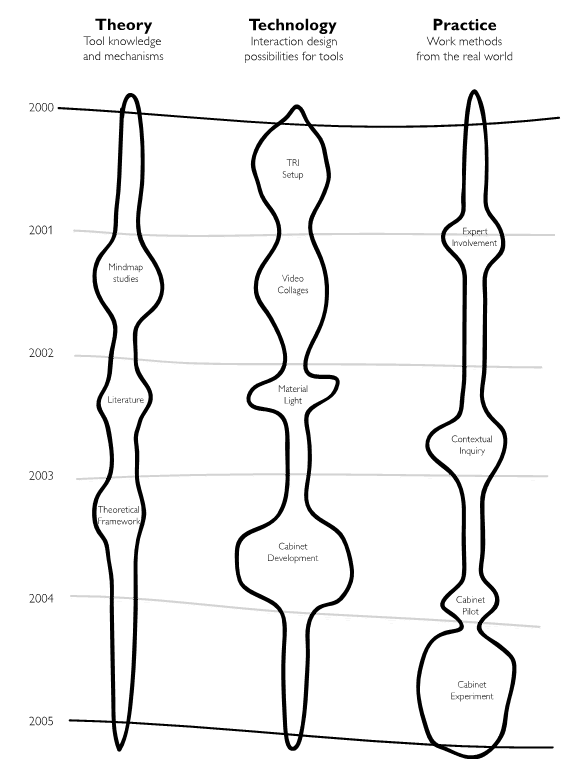
Figure 4.11 – Interaction between exploration of theory, technology, and practice in Keller’s research process (from Keller 2005)

Figure 4.12 – Sleeswijk Visser (2009) sketches her research process by starting with an initial frame of theoretical concepts (left), and filling in that frame through a series of eight case studies (middle), so as to establish connections and refine the understanding of the terms in the final frame (right).
41.3.27 Explicit phases and cycles models
RtD processes are rarely conducted in isolation; they require motivated stakeholders and—often—participants. In some cases, RtD projects are carried out as a large collaborative effort. In these cases in particular, understanding the different dynamics that unfold in the process is vital. According to Basballe and Halskov (2012), an RtD process unfolds along three phases, corresponding to different dynamics among stakeholders in the process: (1) coupling (of research and design interests), (2) interweaving, and (3) decoupling. Coupling is the part of the process where the design and the research interests establish the common point of departure for the main portion of the design process. It establishes a framework for, as well as a set of constraints on the further steps in, the process. Interweaving occurs where one activity or material informs both design and research interests. For example, workshop materials are used to inquire into how three-dimensional spatial and physical representations facilitate the creation of a future scenario (from a research perspective), and to support communication about visitors’ patterns of movement during the discussion of design ideas (from a design perspective). Decoupling occurs when research and design interests are not aligned anymore. For example, in the case of the “Holger the Dane” project described by Basballe and Halskov (2012), the design experiments conducted during the production period and the final installation brought either design or research into focus, and hereby informed, at the time, either design or research. Researchers were interested in the idea of ‘engaging experiences’, whereas designers were interested in a new form of ‘heritage communication’.

Figure 4.13 – Overview of RtD dynamics in a collaborative project (Basballe & Halskov 2012)
41.3.28 Sharing: The way knowledge is communicated
Although there has been ample discussion of the type of knowledge that can come out of RtD, and ways in which it may be documented, much of the knowledge from RtD studies is not transferred ‘in the usual way of journals and conference papers building a common theory’.
Moreover, although several authors put question marks to the generalizability of RtD findings, and even indicate these insights are mostly valuable for the researcher and designers closely involved with the research, there is little discussion as to how the research results (i.e., ‘knowledge’) are transferred to others (i.e., ‘communication’), who those others are (especially when the communication is indirect), and what its use entails. The same goes for discussing how that knowledge has been (re)used in other research or how it has been applied in the design of products.
41.3.29 Audience, channels, and format
Although most writing about RtD is directed at an academic audience, researchers in RtD aim also, some primarily, at (other) design practitioners. Also, the academic writers reveal this aim (e.g., Zimmerman et al. 2007). Cross (1999) used the term design knowledge to indicate that design professionals may use knowledge in different ways and formats than other people would.
“[design knowledge:] forms of knowledge peculiar to the awareness and ability of a designer, just as the other intellectual cultures in the sciences and the arts concentrate on the forms of knowledge peculiar to the scientist or the artist.”
—(Cross 1999)
Koskinen et al. (2011) present a tripartition of lab, field, and showroom. They present this to distinguish not only places and approaches to do research but also different channels to share the results with others. Lab studies are typically carried out in isolation and require other means for dissemination (e.g., articles), often to an academic audience; field studies can share information with beneficiaries through participatory or action research methods. In the showroom format, the prototype itself, plus its framing and annotations, forms the channel for spreading the message.
Many of the studies have been carried out at academic institutes, and some results have been used in the education of future practitioners and researchers, especially in the design schools of those institutes. For instance, techniques around probes and toolkits have found their way through educational channels quite quickly.
Several of the Ph.D. theses referred to in this chapter have high citation counts in Google Scholar. They are read (probably by students and practitioners as well as researchers) because their richness of description satisfies a need that is not served by the journal articles. Especially in the area of user research methods, published Ph.D. theses are read and referred to because of the rich descriptions of new research methods and tools (e.g., 296 citations for Mattelmäki’s thesis, 101 for Sleeswijk Visser’s, and 49 for those by Keller and Wensveen, Google Scholar, retrieved 10 June 2017). The theses are also a place where the researchers can describe creative insights and speculations about the interdisciplinary topics they address. Although these insights can have value for the ‘adjoining’ disciplines, publishing them in ‘their’ journals requires a substantial effort to lodge the insight into the community’s jargon and models of the day. Many adjoining fields can welcome a design project as ‘an illustration of their theories’, but do not seem to be keen on an outsider’s framing.
Even in the academic outlets, publication cultures vary. Gemser et al. (2016) divide design journals into those which are design-related and those which are design-focused, notice that the former currently have a larger academic impact than the latter, and hold that articles in design-related journals refer less frequently to articles in design-focused journals than vice versa. Publications about designerly ways of doing research are typically located in design-focused journals, and in HCI. But also, there are barriers of unawareness, or of values, between these two communities.
Next to academic journals and conferences, there is a tradition in art and design to disseminate through exhibitions and demonstrations, and through critique (as in the RtD conference format, 2014). These can reach a broad audience in inspiring and engaging ways, but leave less of a paper trail for those who were not at the event. Likewise, education to the next generation of designers has been recognized as one of the most effective channels through which design research can have an impact on practice.
Another point concerns the challenge to ensure that the knowledge generated through an RtD process is relevant to designers, design researchers, researchers in other disciplines, and design and design research educators – and, even more importantly, to ensure that it is understandable to them (Höök et al. 2015) and, possibly, to other audiences as well. As mentioned in section 4.1, it is not at once obvious what ‘the’ knowledge that emerges from RtD is.
41.3.30 Incremental building of theory
Traditional methods in practice-based research usually document intermediate stages of the design process with the goal of supporting the reflective knowing and doing cycle (Polanyi 1969). These methods may include written diaries, sketchbooks, design journals, voice recordings, and photographs.
RtD knowledge is typically shared via what is made but also via “reflective accounts of design and use, and discussions relating these elements to other design research to develop nascent theories such as strong concepts, mappings, frameworks, and annotations” (Höök et al. 2015).
In RtD, concerns exist regarding how to turn design explorations into a research method that is rigorous and well-documented enough to be shared and available for scrutiny. It is about how to allow design researchers to engage with and build on one another’s contributions (Zimmerman et al. 2010, Höök et al. 2015). Where rigor and scholarly engagement are to be positioned is still unclear. This is reflected also in the discussion on what ‘implications for design’ in HCI research are to be intended and built on (Kostakos 2015 vs. Reeves 2015; see section 6, conclusion).
According to Höök et al. (2015), the research field “still lacks the means of exploring, documenting, and discussing this knowledge.” The development of novel formats such as pictorials, which are now accepted as an archival format at events such as the Designing Interactive Systems (DIS) conference, represents an important step in this direction (Blevis et al. 2015). Pictorials are now used also at Design & Emotion, and some DRS special interest conferences (e.g., EKSIG 2017).
The many spinoff insights that RtD can deliver can be difficult to publish. For instance, a single project may bring findings about the technology used to make the prototype, about how people’s behavior can be measured, how people arrange a part of their lives, and how a very abstract piece of theory from another domain can be adjusted to fit the situation under study. But when a researcher tries to bring these findings back to their respective domains, the publishing outlet will require him to do extensive background research in that domain so as to ensure not that the finding is new, but that it fits the favorite framings and standard reference base that is needed to be credible in that community. The prototype and the insight do not speak for themselves (Stappers 2007).
Attempts have been made also to develop general tools for documenting design processes for research purposes. For example, the Process Reflection Tool (PRT) developed at Aarhus University (Dalsgaard & Halskov 2012) is a software tool structured in a blog-like format as a list of events, which in turn may be described in greater detail as sub-events. By using PRT, project participants can add their reflections to each event and sub-event. For example, an event may be a planning meeting, a field study, a workshop, or a prototype test. In addition to events, the tool supports ‘brief annotations’, documenting telephone conversations, short e-mail exchanges, and the like. Video and still images may be uploaded and associated. Moreover, the PRT supports the association of reflection on and analysis of the materials with each of the elements, enabling analyses across the project, with regard to specific aspects of the process.
41.4 Conclusions and more…
This chapter has been about the contribution of designerly activities, skills, and tools to the efforts of bringing about knowledge: design for research (to turn the phrase around for once). The period between (roughly) 2007 and 2017 has shown a variety of examples, methods, and approaches as well as the beginnings of a discourse about the value, promise, and challenges for both research and design.
41.4.1 Conclusions
In this chapter we defined RtD as the designerly contribution to new knowledge. But this notion is problematic. In a way, the notion of knowledge as a separate entity comes under stress. In a simple setting (such as an experiment in an established theory, or a student fixed-period assignment in an academic setting), it is clear what a chunk of knowledge can be, and there are ways of reporting it. Within the RtD spectrum, this holds true the most for those projects (Wensveen, Keller, Wright) where the design actions were embedded within a research structure that was familiar from another discipline, such as psychology, engineering or anthropology. Here, the knowledge expectation is framed from the outside. But such is not the case for the projects that are more based on exploration or speculation (Gaver, Mattelmäki, Lundstrom, Rygh), where the research is more open-ended. Keller’s case falls in between, as noted by Koskinen et al., 2011: it has a knowledge goal, but very open expectations, and a value mostly in spinoffs.
What seems to be missing in the discourse is the larger context of the RtD efforts. On the one hand, there is the classical research project, which acts as a client, with an explicit goal (answering a question or mapping effects). On the other hand, there are efforts that are more like open-ended experimentation and learning, where it is unclear how much is gained by those who did not take part.
Longitudinal studies are missing that look not at the prototype in its intervention (if any), but at the way it has influenced others. The traces of that are not easy to track. Much of the transfer lies in informal—but no less real—inspiration rather than cited references in journals. The implications for design offered today in many academic papers are not sufficient for providing reusable data, theory or tools, and facilitate the accumulation of knowledge beyond the practical and the contextual (Kostakos 2015). Research programs, annotated portfolios, and strong concepts offer different but useful means to frame the relevance of the generated knowledge and disseminate it.
Reeves’ (2015) counterargument to the need for open and reusable data is provocative:
“I would argue that the standards of what counts as a generalization, what is a relevant process of accumulation (which I take as the establishing within researchers’ discourse of particular motor themes), and what motivates the conduct of replications should be decided upon as a matter of agreement between relevant researchers. I do not think these things can be determined through adherence to an external and nebulous set of ‘scientific standards’ adopted from a textbook of formal descriptions of the approaches of the natural sciences.”
But what is the reference community for RtD?
Ultimately, we should consider how far we can speak of ‘knowledge’ as a bounded thing in the multifaceted, situated, complex condition in which RtD takes place. In the development of complex systems, knowledge has a short lifespan; it is difficult to isolate from the intervention and the dynamics of the system-in-the-world. In a pragmatist’s view, the value of knowledge is not an intrinsic quality, but lies in its use. Therefore, it makes sense to look beyond the research effort and pay more attention to how the outcomes are used elsewhere later on – by the designer/researcher’s internalized expertise, by those who were involved in the research, by those who received words or images from it, and by others. Looking at the force that started the research likewise makes sense. Many of our examples come from an academic context, where a Ph.D. student or design lab will have to do a research project of a fixed term, often within a funded call for which an academic justification had to be given beforehand. But that’s not the only place where we (hope to) see RtD happen.
41.4.2 Future directions
Is RtD a single thing? Is there a consensus about how it ought to be done, and what it can bring? No, but despite the fact that this is a newly emerging area, there is a lot of coherence, even if uniformity in language is absent. There is a struggle on method, how to arrange a project, and what questions are part of it. There is a challenge on the nature of knowledge, how to deal with the mid-level of abstraction, and what the particular designerly contribution of conceiving and making artifacts, especially prototypes, is. However, although these have clear contributions, which are recognizable also outside of design, there seems to be something missing.
Is RtD a promising direction to make use of design skill sets in research? Yes. Should it be pursued further? Certainly. Will it expand our understanding of knowledge? Of course!
The future of RtD must embrace the creative frictions that spark from different schools of thought and practices, and make them productive for the growing RtD community through a shared set of themes, for which there are no—and perhaps there should not be—final answers. What will matter is not whether we agree with the artifact’s being a manifestation or a provocation, whether we use it as a vehicle for critique or for developing theories, or whether RtD artifacts should be simple props or fully functional and polished. To gain insight from an artifact, we need to have a framing. And it’s the framing that addressing a coherent and shared set of interrelated themes can provide, one which will help us ask new questions, craft new experiments, and develop a mature RtD discourse.
41.4.3 Where to learn more
The role of design(ers) in research has been growing rapidly since around 2005, both in recognition and in content. Nevertheless, as we indicated in the chapter, the field is still finding its language and its examples, and determining whether or how to fit the diversity of approaches under one or more umbrellas. The literature is spread over a variety of sources.
41.4.3.1 Journals and conferences
This is where the academic debate takes place and themes are fleshed out. Most of the papers cited in this chapter are from conferences and journals that pay attention to design research methods. This is also where we expect the discussion will continue, in ACM conferences, especially:
CHI Conference on Human Factors in Computing Systems (https://chi2017.acm.org)
DIS Designing Interactive Systems (http://dis2017.org)
RTD Research Through Design (https://researchthroughdesign.org/)
DRS Design Research Society (http://www.designresearchsociety.org/cpages/conferences)
PDC Participatory Design Conference (http://pdc2016.org)
Michel, R. (2007) Design Research Now. Basel: Birkhäuser
contains a number of essays and example projects of design-led research;Koskinen, I., Zimmerman, J., Binder, T., Redström, J., & Wensveen, S. (2011). Design research through practice: From the lab, field, and showroom. Elsevier.
is a classroom introduction to design research positioned in the center of the RtD field.
And in design conferences with a method focus, such as:
41.4.3.2 Books and chapters
Research through Design has been addressed in depth in two books with contributions from different perspectives, especially regarding prototypes and the role of making as a part of doing research.
Next to that, much of the discussion of methods in Research through Design builds on discussions of research methods in social sciences, such as action research. For these, there are handbooks about research methods, such as those listed below:
Ned Kock. Action Research. Chapter 33. The Encyclopedia of Human-Computer Interaction, 2nd Ed. (https://www.interaction-design.org/literature/book/the-encyclopedia-of-human-computer-interaction-2nd-ed)
Bryman, A. (2015). Social Research Methods. Oxford University Press.
Next to those, the history of innovation, invention, and science contains many examples of ‘great scientific experiments’ which show that scientific discovery and validation can take very diverse paths (see appendix 8.4).
41.4.3.3 Published theses
Many of the well-documented RtD studies have been Ph.D. theses, especially from Scandinavia and the Netherlands, where these are published in book form, often made available on the internet. Theses contain detailed descriptions of what was done as well as justifications for why certain methods were used (often argued in comparison to traditional research paradigms, or justifying the designerly contribution and motivation). They are far richer sources of examples and illustrations than journal and conference articles, which have tight page limits. In table 5.1, the Ph.D. theses are marked with an asterisk (*). All of these were easy to find online.
Theme |
1 Knowledge |
2 Artifacts |
3 Learning |
4 Sharing |
1953 | Wittgenstein | |||
1981 | Archer | |||
1983 | Schön | |||
1992 | Mogensen | |||
1993 | Feyerabend | |||
1999 | Cross | Cross | Cross | Cross |
2000 | Buchenau & Fulton Suri | |||
2003 | Lindwell et al. | Gaver et al. | Zimmerman | |
2004 | Tsaknaki et al. | |||
2005 | Keller* Wensveen* | Keller* | ||
2006 | Frens* Mattelmäki* | Binder & Redström | ||
2007 | Stappers | Mäkelä Stappers Zimmerman et al. | Brandt & Binder Zimmerman et al. | Stappers |
2008 | Stolterman | Lim et al. Mazé & Redström | Fernaeus et al. | |
2009 | Lucero* Sleeswijk Visser* Stappers & Hoffman | Keyson & Bruns-Alonso Mattelmaki & Matthews Sleeswijk Visser* | ||
2010 | Stolterman & Wiberg | Halse et al. | Zimmerman et al. | Zimmerman et al. |
2011 | Brand et al. Koskinen et al. | Redström | Koskinen et al. | |
2012 | Bardzell et al. Bowers Gaver & Bowers Höök & Löwgren | Bardzell et al. Boer & Donovan Sanders & Stappers | Bardzell et al. Basballe & Halskov Gaver & Bowers | Dalsgaard & Halskov |
2013 | Ingold Löwgren | Kuijer et al. Stappers | ||
2014 | Stappers et al. | Pierce & Paulos Stappers & Sleeswijk Visser Wensveen & Matthews | Bang & Eriksen Bourgeois et al. Stappers et al. | |
2015 | Höök et al. | Odom & Wakkary Pierce & Paulos Wakkary et al. | Höök et al. Wensveen & Matthews | Blevis et al. Höök et al. Kostakos Reeves |
2016 | Karana et al. | Giaccardi et al. Mejia Odom et al. Smith et al. Wakkary et al. | Gemser et al. | |
2017 | Giaccardi | EKSIG |
Table 5.1 – Publications cited in section 4’s RtD literature themes (bold if they are cited more than 5 times within the works in the reference list; italics if they are cited as examples of RtD, or general sources, rather than bringing theory on RtD; asterisks mark published Ph.D. theses).
This work is part of the research program Research Through Design with project numbers 14608 and 14577, which is (partly) financed by the Netherlands Organisation for Scientific Research (NWO) and the Taskforce for Applied Research SIA.
41.5 References
Bang, A. L., & Eriksen, M. A. (2014). Experiments all the way in programmatic design research. Artifact, 3(2), 4-1.
Bardzell, S., Bardzell, J., Forlizzi, J., Zimmerman, J., and Antanitis, J. (2012). Critical design and critical theory: The challenge of designing for provocation. In Proc. of DIS 2012. ACM: New York.
Basballe, D. A., & Halskov, K. (2012, June). Dynamics of research through design. In Proceedings of the Designing Interactive Systems Conference (pp. 58-67). ACM.
Bernstein, M. (1996). Grand eccentrics: turning the century: Dayton and the inventing of America. Orange Frazer Press.
Binder, T. & Redström, J. (2006) Exemplary Design Research, Proc. Wonderground 2006, Redström 2011, Ph.D. theses
Blevis, E, Hauser, S., Odom, W. (2015) Sharing the hidden treasure of pictorials, interactions, 22(3), 32-43.
Boer, L., & Donovan, J. (2012, June). Provotypes for participatory innovation. In Proceedings of the designing interactive systems conference (pp. 388-397). ACM.
Boess, S. (2009). Designing in research: Characteristics and criteria. Rigor and Relevance in Design.
Bowers, J. (2012, June). The logic of annotated portfolios: communicating the value of 'research through design'. In Proceedings of the Designing Interactive Systems Conference (pp. 68-77). ACM.
Brandt, E., & Binder, T. (2007). Experimental design research: genealogy, intervention, argument. International Association of Societies of Design Research, Hong Kong.
Brandt, E., Redström, J., Eriksen, M. A., & Binder, T. (2011). XLAB. The Danish Design School Press, Denmark.
Brandt, E. (2016). The Perform Codesign Experiment – on what people actually do and the relation between program and experiment in research through design. In Proceedings of IASDR 2015 Interplay (pp. 234-249).
Buchenau, M., & Fulton Suri, J. (2000). Experience prototyping. In Proceedings of the 3rd conference on Designing interactive systems: processes, practices, methods, and techniques (pp. 424-433). ACM.
Cox, D. J. (2005) “Visualizing the Cosmos,” in INSAP Inspiration of Astronomical Phenomena, Fifth International Conference Proceedings, June 26 – July 1, 2005, pg. 52; invited speaker, Friday, July 1, 2005.
Crampton-Smith, G. (2006) Design as research that makes a difference. In: van der Lugt, R., and Stappers, P. J., (Eds) Design and the Growth of Knowledge. Delft, the Netherlands: ID-StudioLab Press
CRISP (2015) Is it a Service? Is it a Course? It’s Super-Maker! In van Erp, J., de Lille, C., Vervloed, J., den Hollander, M., Aretz, D. CRISP 5: This is Crisp. Creative Industry Scientific Programme. Page 5.
Cross, N. (1999) DesignResearch: A Disciplined Conversation. Design Issues 15, 2, 5-10.
Dalsgaard, P., & Halskov, K. (2012, June). Reflective design documentation. In Proceedings of the Designing Interactive Systems Conference (pp. 428-437). ACM.
Dalsgaard, P., Halskov, K. Basballe, D.A. (2014) Emergent Boundary Objects and Boundary Zones in Collaborative Design Research Projects, DIS 2014
Dalsgaard, P., Halskov, K., Bardzell, J., Bardzell, S. & Lucero, A. (2016) Documenting Design Research Processes, DIS 2016
Desmet, P., Overbeeke, K., & Tax, S. (2001). Designing products with added emotional value: Development and application of an approach for research through design. The Design Journal, 4(1), 32-47.
Djajadiningrat, T., Wensveen, S., Frens, J., & Overbeeke, K. (2004). Tangible products: redressing the balance between appearance and action. Personal and Ubiquitous Computing, 8(5), 294-309.
Dunne, A., & Raby, F. (2001). Design noir: The secret life of electronic objects. Springer Science & Business Media.
Fallman, D. (2007). Why research-oriented design isn’t design-oriented research: On the tensions between design and research in an implicit design discipline. Knowledge, Technology & Policy, 20(3), 193-200.
Faste, T., & Faste, H. (2012). Demystifying “design research”: Design is not research, research is design. In IDSA Education Symposium.
Fernaeus, Y., Tholander, J., & Jonsson, M. (2008, February). Towards a new set of ideals: consequences of the practice turn in tangible interaction. In Proceedings of the 2nd international conference on Tangible and embedded interaction (pp. 223-230). ACM.
Feyerabend, P. (1993). Against method. Verso.
Frayling, C. (1993) Research in Art and Design. Royal College of Art Research Papers, 1(1), 1-5
Frayling, C. (2015) Closing Provocations of the 2015 Research through Design conference. http://rtd2015.herokuapp.com/programme/ frayling
Frens, J. (2006). Designing for rich interaction. Integrating form, interaction, and function. Ph.D. Thesis. Eindhoven University of Technology, the Netherlands.
Friedman, K. (2008) Research into, by, and for design. Journal of Visual Arts Practice 7(2), 153-160.
Gaver, W., Beaver, J., Benford, S. (2003). Ambiguity as a Resource for Design. Proc. of CHI ’03, 233-240.
Gaver, W. (2012, May). What should we expect from research through design?. In Proceedings of the SIGCHI conference on human factors in computing systems (pp. 937-946). ACM.
Gaver, B., & Bowers, J. (2012). Annotated portfolios. interactions, 19(4), 40-49.
Giaccardi, E. (2017). Histories and Futures of Research through Design, Opening provocation RTD 2017, Edinburgh, UK: March 21, 2017.
Giaccardi, E., Speed, C., Cila, N., Caldwell, M. (2016) Things as Co-Ethnographers: Implications of a Thing Perspective for Design and Anthropology. In R.C. Smith et al. (ed) Design Anthropological Futures, Bloomsbury Publishing.
Hanington, B., & Martin, B. (2012). Universal methods of design: 100 ways to research complex problems, develop innovative ideas, and design effective solutions. Rockport Publishers.
Harré, R. (1981). Great scientific experiments: Twenty experiments that changed our view of the world. Phaidon Press
Hermans, G. (2015) Opening Up Design: Engaging the Layperson in the Design of Everyday Products, Ph.D. dissertation, Umeå Institute of Design, Umeå, Sweden.
Höök, K., & Löwgren, J. (2012). Strong concepts: Intermediate-level knowledge in interaction design research. ACM Transactions on Computer-Human Interaction (TOCHI), 19(3), 23.
Höök, K., Bardzell, J., Bowen, S., Dalsgaard, P., Reeves, S., Waern, A. (2015) Framing IxD Knowledge, XXII.6 November–December 2015, p. 32.
Horváth, I. (2007) Comparison of three methodological approaches of design research, International Conference on Engineering Design, ICED’07, 28-31 August 2007
Ingold, T. (2013) Making: Anthropology, Archeology, Art, & Architecture. Routledge.
Jonas, W. (2007). Research through DESIGN through research: A cybernetic model of designing design foundations. Kybernetes, 36(9/10), 1362-1380.
Keller, A. I. (2005). For Inspiration Only; Designer interaction with informal collections of visual material. Ph.D. dissertation, Delft University of Technology, Delft, Netherlands.
Keller, A. I., Sleeswijk Visser, F., van der Lugt, R., & Stappers, P. J. "Collecting with Cabinet: or how designers organise visual material, researched through an experiential prototype." Design Studies 30, no. 1 (2009): 69-86.
Keyson, D. V., & Bruns Alonso, M. (2009, October). Empirical research through design. In Proceedings of the 3rd IASDR Conference on Design Research (pp. 4548-4557).
Koskinen, I., Zimmerman, J., Binder, T., Redström, J., & Wensveen, S. (2011). Design research through practice: From the lab, field, and showroom. Elsevier.
Kostakos, V. (2015) The Big Hole in HCI Research. ACM interactions, 22:2 (March-April 2015), 48-51.
Kuijer, L., de Jong, A. M., & van Eijk, D. (2013). Practices as a unit of design. ACM Transactions on Computer-Human Interaction, 20(4):21.
Laurel, B. (2003). Design research: Methods and perspectives. MIT press.
Lim, Y. K., Stolterman, E., & Tenenberg, J. (2008). The anatomy of prototypes: Prototypes as filters, prototypes as manifestations of design ideas. ACM Transactions on Computer-Human Interaction (TOCHI), 15(2), 7.
Löwgren, J. (2013). Annotated portfolios and other forms of intermediate-level knowledge. Interactions, 20(1), 30-34.
Löwgren, J. (2016) On the significance of making in interaction design research. Interactions, 23(3), 26-33.
Lundström, A. (2016) Designing Energy-Sensitive Interactions – Conceptualising Energy from the Perspective of Electric Cars, Ph.D. Dissertation, KTH Royal Institute of Technology, Stockholm, Sweden.
Lucero Vera, A. (2009). Co-designing interactive spaces for and with designers: supporting mood-board making. Thesis, Eindhoven University of Technology.
Mäkelä, M. (2007) Knowing through making: The role of the artefact in practice-led research. Knowledge, Technology & Policy 20(3): 157-163.
Mattelmäki, T. & Matthews, B. (2009) Peeling apples: Prototyping Design Experiments as Research, in Proceedings of Nordes 09, Oslo.
Mattelmäki, T. (2006). Design probes. Aalto University.
Mejia, J.R., Hultink, E. J., Pasman, G., Stappers, P.J. (2016). Concept Cars as a design-led futures technique. Proceedings of the 23rd Innovation and product development management conference, Glasgow.
Miller, G. A. (1956). The magical number seven, plus or minus two: Some limits on our capacity for processing information. Psychological review, 63(2), 81.
Mintzberg, H., & Westley, F. (2001). Decision making: It's not what you think. MIT Sloan Management Review, 42(3), 89.
Mogensen, P. (1992). Towards a Provotyping Approach in Systems Development. Scandinavian Journal of Information Systems, 4, 31-53
Nimkulrat, N. (2007) The Role of Documentation in Practice-Led Research, Journal of Research Practice, Volume 3, Issue 1, Article M6, 2007
Odom, W., & Wakkary, R. (2015, June). Intersecting with Unaware Objects. In Proceedings of the 2015 ACM SIGCHI Conference on Creativity and Cognition (pp. 33-42). ACM.
Pierce, J., & Paulos, E. (2014). Counterfunctional Things: Exploring Possibilities in Designing Digital Limitations. Proc. DIS ’14.
Pierce, J., & Paulos, E. (2015, April). Making multiple uses of the obscura 1C digital camera: reflecting on the design, production, packaging and distribution of a counterfunctional device. In Proceedings of the 33rd Annual ACM Conference on Human Factors in Computing Systems (pp. 2103-2112). ACM.
Polanyi, M. (1969). Knowing and being. Chicago: University of Chicago Press.
Redström, J. (2011). Some Notes on Program/Experiment Dialectics. In Nordic Design Research Conference 2011 (pp. 1-8). Helsinki, Finland: Nordes.
Reeves, S. (2015) Locating the 'big hole' in HCI research. ACM interactions, 22:4 (July-August 2015), 53-56.
Rodgers, P., & Yee, J., Eds (2014). The Routledge Companion to Design Research. Routledge.
RTD conference series (from 2015) http://researchthroughdesign.org/
Rygh, K. (Ed) (2015a) Super-Maker. Eindhoven: The Design Academy. ISBN 978-94-91400-20-9
Rygh, K. (2015b) http://www.super-maker.tumblr.com/
Sanders, E. B.-N. (2005). Information, inspiration and co-creation. The 6th International Conference of the European Academy of Design. Bremen, Germany.
Sanders, E. B. N., & Stappers, P. J. (2012). Convivial toolbox: Generative research for the front end of design. BIS.
Sanders, L., & Stappers, P. J. (2014). From designing to co-designing to collective dreaming: three slices in time. ACM Interactions, 21(6), 24-33.
Schattschneider, D. (2010). The mathematical side of MC Escher. Notices of the AMS, 57(6), 706-718.
Sleeswijk Visser, F. (2009). Bringing the everyday life of people into design. Ph.D. dissertation, Delft University of Technology, Delft, Netherlands.
Smith, R. C., Vangkilde, K. T., Kjaersgaard, M. G., Otto, T., Halse, J., Binder, T. (eds) (2016) Design Anthropology Futures. Bloomsbury.
Stappers, P. J. (2007). Doing design as a part of doing research. In: Michel, R. (Ed.), Design research now: essays and selected projects. Basel: Birkhäuser, 81-91.
Stappers, P. J. (2007b) Designing as a Part of Research. In: van der Lugt, R. & Stappers, P. J. (Eds) Design and the Growth of Knowledge: best practices and ingredients for successful design research. Delft: StudioLab Press, 12-17.
Stappers, P. J. (2013) Prototypes as central vein for knowledge development. Valentine, L. (Ed). Prototype: craft in the future tense. 85-97.
Stappers, P. J., & Flach, J. M. (2014). Foreshadowing the Future. Crisp Magazine, 3(2).
Stappers, P. J., & Hoffman, R. R. (2009) Once more, into the soup. IEEE Intelligent Systems, 24 (5), 9-13.
Stappers, P. J., & Sleeswijk Visser, F. (2014) Meta-levels in design research: Resolving some confusions. In: YK Lim, K Niedderer, J Redstrom, E Stolterman, A Valtonen (eds.), DRS 2014: Design's big debates, Umea, Sweden, June 16-19, 2014, Printed by: Umeå Institute of Design, Umeå, 2014, pp. 847-857.
Stappers, P. J., Sleeswijk Visser, F., & Keller, A. I. (2014). The role of prototypes and frameworks for structuring explorations by research through design. In: Rodgers, P. & Yee, J. (2014) The Routledge Companion to Design Research.
Stokes, D. E. (1994). Completing the Bush model: Pasteur’s quadrant. Centre for Science, Policy and Outcomes.
Stokes, D. (1997) Pasteur’s quadrant: Basic science and technological innovation. Washington, D.C.: Brookings Institution Press.
Stolterman, E. (2008). The nature of design practice and implications for interaction design research. International Journal of Design, 2(1).
Stolterman, E., & Wiberg, M. (2010). Concept-driven interaction design research. Human–Computer Interaction, 25(2), 95-118.
Swann, C. (2002). Action research and the practice of design. Design issues, 18(1), 49-61.
Tsaknaki, V., Fernaeus, Y., Schaub, M. (2014) Leather as a material for crafting interactive and physical artifacts. In Proceedings of the 2014 ACM Conference on Designing Interactive Systems (pp. 5-14). New York: ACM Press.
Van der Lugt, R. & Stappers, P. J. (2006) Design and the Growth of Knowledge. Delft: StudioLab Press
Wakkary, R., Lin, H., Mortimer, S., Low, L., Desjardins, A. Doyle, K., Robbins, P. (2016) Productive Frictions: Moving from Digital to Material Prototyping and Low-Volume Production for Design Research. In Proceedings of the 2016 ACM Conference on Designing Interactive Systems (pp. 1258-1269). New York: ACM Press.
Wakkary, R., Odom, W., Hauser, S., Hertz, G., & Lin, H. (2015, August). Material speculation: Actual artifacts for critical inquiry. In Proceedings of The Fifth Decennial Aarhus Conference on Critical Alternatives (pp. 97-108). Aarhus University Press.
Wensveen, S. (2005). A Tangibility Approach to Affective Interaction. Delft University of Technology, Dissertation.
Wensveen, S., & Matthews, B. (2015). Prototypes and prototyping in design research. In: Rodgers, P., & Yee, J. (2014) The Routledge Companion to Design Research.
Wensveen, S., Overbeeke, K., Djajadiningrat, T., & Luxen, R. (2002). A nod is as good as a wink to a blind horse: How rich behavioural interaction opens up the experiential.
Wensveen, S., Overbeeke, K., & Djajadiningrat, T. (2002, June). Push me, shove me and I show you how you feel: recognising mood from emotionally rich interaction. In Proceedings of the 4th conference on Designing interactive systems: processes, practices, methods, and techniques (pp. 335-340). ACM.
Wittgenstein, L. (1953). Philosophical Investigations. Oxford: Blackwell Publishing.
Zimmerman, E. (2003) Play as Design: the iterative design process. In: Laurel, B. (Ed), Design Research, MIT Press
Zimmerman, J., Forlizzi, J., & Evenson, S. (2007, April). Research through design as a method for interaction design research in HCI. In Proceedings of the SIGCHI conference on Human factors in computing systems (pp. 493-502). ACM.
Zimmerman, J., Stolterman, E., & Forlizzi, J. (2010, August). An analysis and critique of Research through Design: towards a formalization of a research approach. In Proceedings of the 8th ACM Conference on Designing Interactive Systems (pp. 310-319). ACM.
41.6 Appendix: Framings in types of research
Research through Design is often presented as a different way of doing research – i.e., different from the experimental approach common in CHI areas such as usability testing, or the strict methods of statistical hypothesis testing in the ‘standard scientific experimental approach’. In fact, most authors agree that the contribution of the designer to ‘create a future’ is a distinguishing trait of RtD.
Why should we be looking more broadly? In positioning RtD as a way for designers to do research, some comparisons have been made so as to set it off against specific forms of ‘traditional’ research. Zimmerman et al. (2010) make the comparison with (i.e., against) tech-focused usability; Gaver (2012) positions it against philosophers of science Popper and Kuhn. But the spectrum is much richer, as design is not just art set against positivistic models, but in between several traditions from which it can take—and to which it can bring—valuable perspectives.
In this section, we present four models from outside the RtD core discourse which we believe shed a light on the themes discussed earlier. They can be regarded as extended footnotes on research methodology. This also shows that the themes/issues discussed in section 4 are part of broader reflection on method that exists outside the academic design community for design research to engage with. And it shows that the topic of ‘What do designerly ways of going about things contribute to research?’ fits into a much larger area of thinking in business and engineering.
41.6.1 Horvath’s 3 types of research
Horvath reviewed the approaches used in dozens of Ph.D. projects at the faculty of Industrial Design Engineering at TU Delft (Horvath 2007), and constructed three categories shown in Figure 5.1, distinguishing three types of research he refers to as framing methodologies, defined as:
“a framing methodology: (i) introduces a strategy of reasoning, (ii) indicates a possible research design (a structure and set-up of research actions), and (iii) the way research actions are to be done.”
—(Horvath 2007, p. 4)
The Ph.D. projects resided in between—on the one hand—research, as conducted in established academic disciplines (e.g., psychology, engineering, marketing, often referred to as ‘basic’ or ‘fundamental’ science), and—on the other hand—industrial design practice (sometimes referred to as ‘applied practice’, but typically not published). In between those extremes lie the three categories. The different categories resemble the distinctions that Zimmerman, Forlizzi, and Evenson (2007) see between interaction design researchers and HCI researchers. Closest to the established disciplines was Research In Design Context, where the methods, theories (and journals) of the established disciplines were used, but design featured as an object of research. Closest to the industrial practice side was Practice-Based Research, in which designers reflected on a series of design projects to extract general insights. These constitute knowledge, but the prime motivator of the projects was always a design result and the knowledge a spinoff, often at a meta-level of design methods. In the middle category lies RtD, which Horvath labels Design Inclusive Research. In this category, the goal of the work is knowledge, but design competence brings an essential contribution.

Table 7.1 – Horvath’s three types of research 2007
There appear to be two different roles that designerly action can take in this central category. In one view, the research follows a ‘traditional path’ from theory, to hypothesis, to stimulus (prototype), to evaluation, and then to adjusting the theory. In this approach, the contribution of the designer is to bridge the gap between (abstract) hypothesis and (concrete) stimulus. Creating the prototype/stimulus is recognized as a valuable and challenging task, without which the research would be impossible. But it is often also seen as a separate task – i.e., the reasoning that progresses the theory is seen as one activity, and the reasoning that delivers a prototype to match the hypothesis can be entirely separate. Here, the research is theory-driven.
A fundamentally different view is the discovery-driven approach, in which the designerly reflective actions of creating the prototype (and including and dropping theories as appears opportune) are seen as central and those of theory as supporting. Here, theoretical insights are more spinoffs than a driving force.
The examples in section 3 illustrate these divisions. Wensveen’s experiment-with-designed-prototype and Keller’s prototypes-with-theory-spinoffs span the central category. Gaver’s open exploration fits practice-based design (although there are many less outspoken examples in this category). We haven’t included an example from the RIDC category, because in that design qualities are merely objects of study, not elements of method.
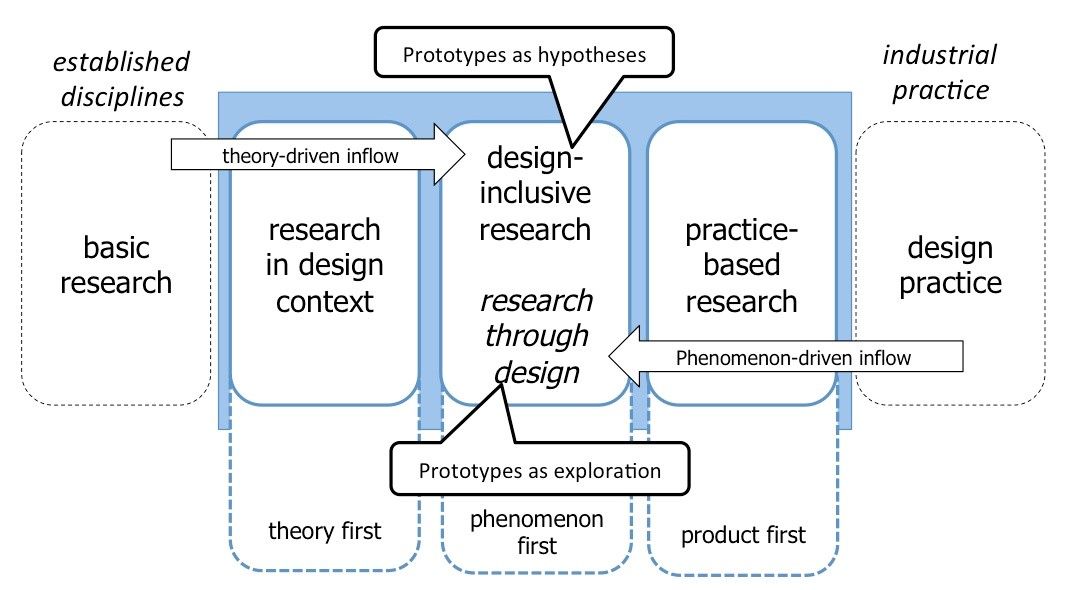
Figure 7.2 – Horvath (2007) identified three approaches emerging in academic design research, and set them apart from basic research and design practice. Stappers et al. (2014) distinguish two approaches within the central box, based on the role of the prototype and reflections from the ‘act of designing’ (from Stappers et al. 2014).
41.6.2 Mintzberg & Westley’s three ways of decision making
Mintzberg and Westley (2001) criticized the decision-making approaches in management theory, by indicating that there are alternatives to rational extrapolation. The distinctions they make apply to design as well as to decision making. Table 7.3 shows three approaches, in which disciplines they are practiced, and under what circumstances they can be used.
For a designer, all three are possibly equally important, and to a degree constitute everyday activities: extrapolate where you understand a problem, envision where you have to make a unified view out of incomplete and conflicting data, and go trying things out when you have insufficient experience in the area. Design builds on science, on art, and on craft and engineering.
In the examples discussed in section 3, we recognize the appearance of not just one, but all of these approaches. Interestingly, in scientific publications, there is a strong bias to reporting only the first category (“be clear about the manipulations and the results, and how you argue for your conclusions”), but very little room is given to the source of inspirations, the resolution of conflicts, or the large set of abandoned directions of experiments (even though the philosophical handbooks tell us that we learn most from mistakes and refutation).
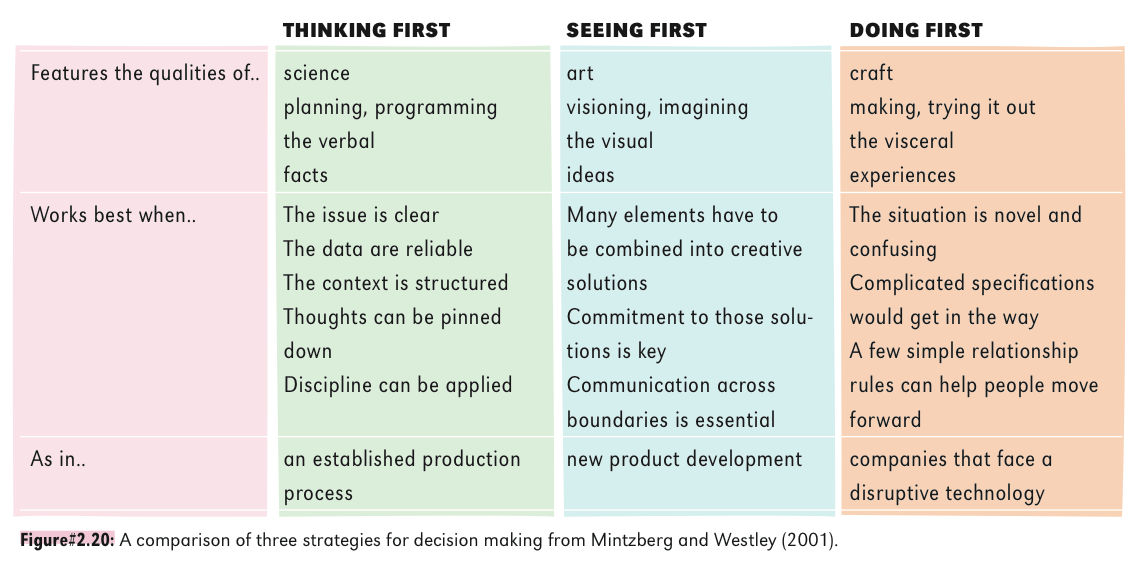
Table 7.3 – Mintzberg & Westley’s (2001) three ways of decision making
41.6.3 Stokes’ breaking up of the Basic-versus-Applied Research Dimension
Although the terms ‘basic/fundamental’ and ‘applied’ research are not used as much as they were around the turn of the century, these still rule most of the thinking about how research can be valuable (and worth funding). Stokes (1993, 1997), analyzing research funding policies, criticized this distinction as overly simplified and missing valuable types of research. He traces the distinction to Vannevar Bush’s policy advice at the end of World War II. (See Figure 7.4.) The wisdom of the day was such that just as scientific research had helped win the war, it needed to be put to use for economic benefit. Bush’s model placed all research on a single continuum between the poles of basic and applied, where new ideas originating in basic research would trickle down to applied research and application in industry and societal benefit, just like Quantum Theory helped to build The Bomb. With this comes the idea that basic and applied are opposites, and that any move in one direction implies a move away from the other. This view of science is still widely held by academics and in the popular press. (pj: I remember my astronomy professor saying in one lecture that he was proud nobody could apply his theory, so therefore it had to be more basic, and thus more valuable). But, Stokes argues, this view is flawed, and misses out on important research work.

Figure 7.4 – In Vannevar Bush’s model, basic and applied research are opposite poles on one dimension, and any move toward the one is a move away from the other; it is unclear where the work of Pasteur would fit, as it is both generalizable and aimed at application (after Stokes 1993).
Stokes proposes that basic and applied are not two opposite poles, as shown in Figure 5.4, but actually two independent dimensions, and he populates the 2-by-2 table in Figure 5.5 with the opposite examples of Niels Bohr (basic research, no desire for application), Thomas Edison (applied research, no desire for generalization), and Louis Pasteur, inventor of vaccination and pasteurization (applied) and founder of microbiology, disproving the theory of spontaneous generation (basic). Pasteur managed to combine applied and basic research. Stokes’ main argument was that basic and applied aspects are not mutually exclusive, and that the Pasteur-like qualities should be cherished (whereas research funding schemes tended to favor only the Bohr and Edison areas). Stokes also rejects the mutually exclusive nature of basic and applied, and replaces and reconciles them by making them independent matters of degree, qualities he labels ‘an eye for generalization’ and ‘an eye for application’, respectively.
There is a fourth box, which is not discussed in Stokes’ original book—namely, that of research which is done for neither generalization nor application. What fits in this box is the making of collections, as was seen from the 17th–19th centuries (e.g., collections of minerals and butterflies, the careful organizing of animal sorts by Linnaeus, the observations that Leeuwenhoek made with his microscope). Work in this box was not motivated by either generalization or application, yet it laid the foundations for others to construct theories and applications.
Research through design, with its double commitment to creating new solutions and new insights, may have a claim to make for the two diagonal boxes: those in which both general insights and local solutions are made (whether the driving force is theory or application), and those in which pure exploration is conducted (but presented in ways that let others continue on them).
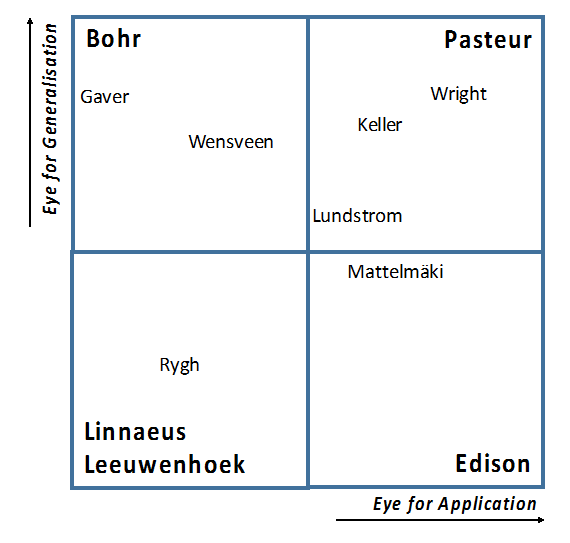
Figure 7.5 – Stokes’ model replaces the two poles by two separate dimensions, which can be satisfied at the same time, as exemplified by Louis Pasteur’s work. Both diagrams are modeled after Stokes (1993); the seven examples of section 3 are tentatively positioned on this map.
So, how does this connect to Research through Design? Can designers have the best of both worlds, like Pasteur? Should they strive for that? Maybe the most apparent connection lies in how the roles of prototypes are considered in each of them, as seen in Table 5.6.
Eye for Generalization | Bohr Prototypes as stimuli to test a hypothesis | Pasteur Prototypes as new realities to study |
Artifacts* as collections of examples Linnaeus, Leeuwenhoek | Prototypes as new realities to implement Edison | |
Eye for Application |
Table 7.6 – Stokes’ model and the relation of RtD. *In the Leeuwenhoek quadrant we write ‘artifacts’, not ‘prototypes’ (because these artifacts stand in themselves and are not positioned as being proto to some other thing).
The above discussion brings out how varied the harvest from the combination of Research and Design can be. It entails aspects of discovery and invention, finding instantiations for abstract theories and generalizing from concrete experiences, elements of validation and provocation, inspiration, and proof of possibility. Different stakeholders emphasize different aspects.Harré’s varieties of experiments
In figuring out what is special about RtD, several authors have made comparisons to certain established, historical approaches. Zimmerman et al. (2010) make a comparison to the measurement-driven methods of usability research, Gaver (2012) compares RtD to Popper’s strict experimental method, and to Kuhn’s concepts of paradigm; Koskinen et al. < 2011> refer to Lakatos’ notion of scientific programs. These are illustrations that there is no single method that is required and sufficient for the successful production of knowledge (Feyerabend, 1993, argued this is impossible).
The philosopher of science Harré (1992) describes the variety of methods that lay behind historical scientific breakthroughs, in order to illustrate how different researchers went about discovering, establishing, measuring, and proving the scientific facts we now take for true. In his book, he gives a popular-science description of 20 scientific ‘experiments’, and discusses the logic behind them.
Four famous examples (Harré gives twenty) indicate how varied the methods of researchers have been.
Aristotle was the first to describe the development of a chick in an egg, by opening eggs 1, 2, 3… days after they were laid. Beaumont established the chemical nature of digestion, by systematically putting food items into a living human’s stomach and taking them out again after certain times, making use of the convenient presence of a soldier with a war wound which had left him with a stomach with a ‘side entry’.
Theodoric of Freiburg found an explanation of the shape and position of the rainbow(s) by studying how light is reflected by a glass bottle, and reasoning that the bottle is a model for the waterdrops in the sky.
Michelson and Morley, intent on measuring the movement of the æther, designed, built, and measured a light interferometer, for 25 years, each time producing a null result, which proves ‘nothing’ in a hypothesis-testing approach. Yet this very failure was recognized as the basis for the rejection of æther theories, and lay the ground for the theory of relativity.
Gibson’s cookie-cutter experiment demonstrated the dangers of isolating simple-to-measure variables in studying human perception: when someone gets a cookie-cutter-shape pressed, or turned, onto the palm of his hand, he has great difficulty in recognizing its shape; when given the opportunity to explore it with his fingers, however, he has no problem identifying it.
The variety of methods, along with the impact of the findings, resists any single model of how knowledge is found. Some involve measurement, some the construction of elaborate measurement materials, and some acute metaphorical thinking. In some, demonstration and framing are the essence, and no repeat measurements or statistics are needed. Some bring a contribution that is based on trying out variations, or just being systematic regarding descriptions. All of these approaches are part and parcel of designers’ skills in finding solutions in their projects.
[1] (Note: the very combination design research is used in the literature both for three different meanings: research into design, as in Journal of Design Research, as research for design, especially user research, as in contemporary UX job vacancies, and also to refer to RtD.)
